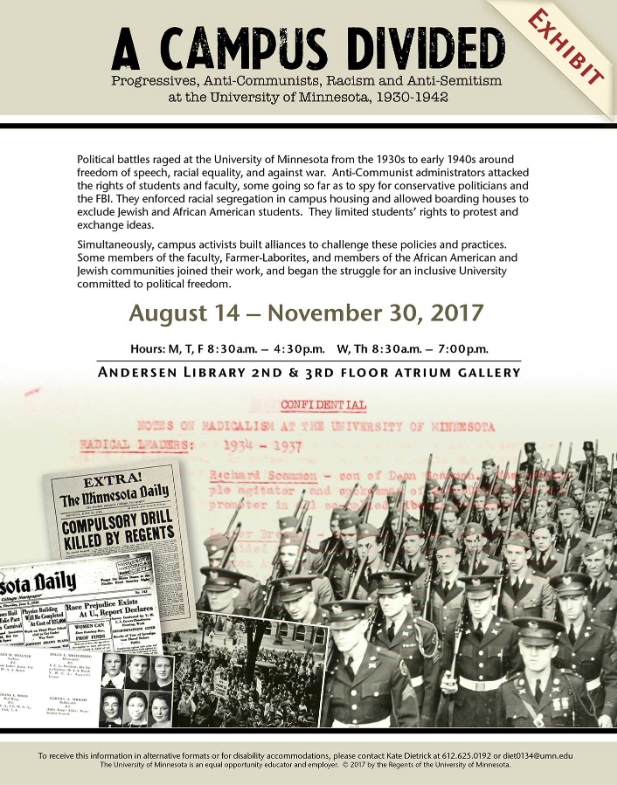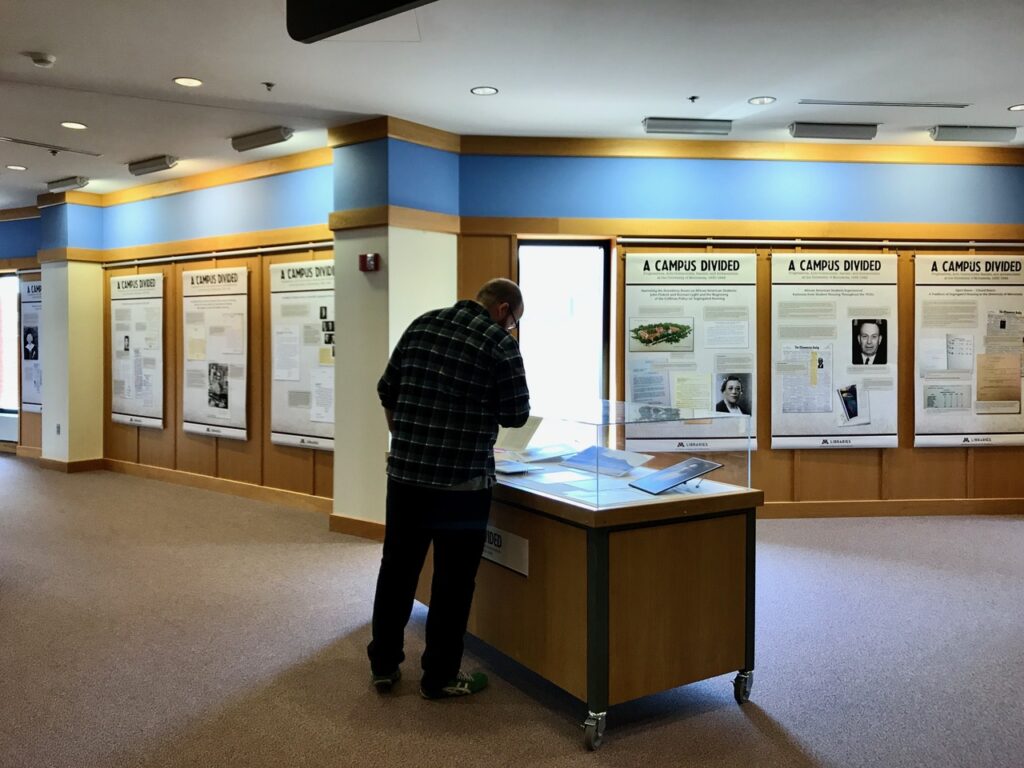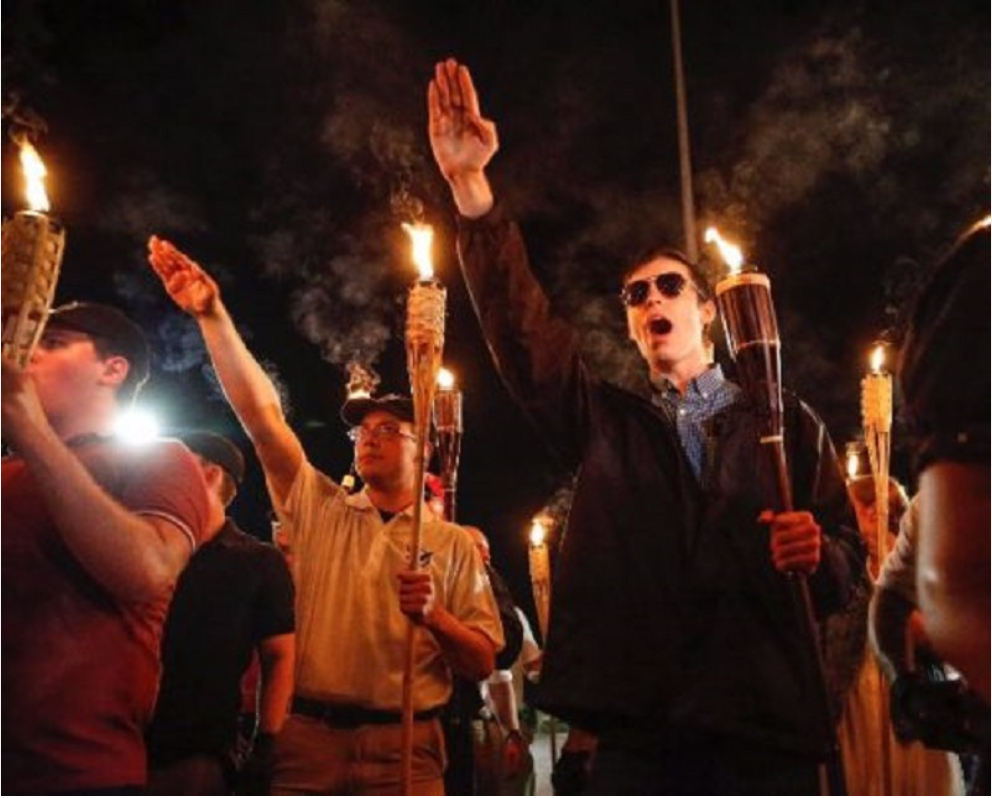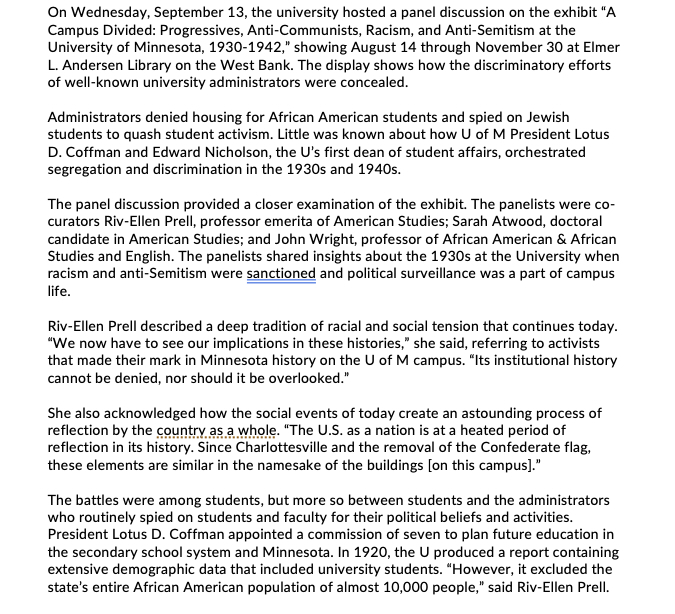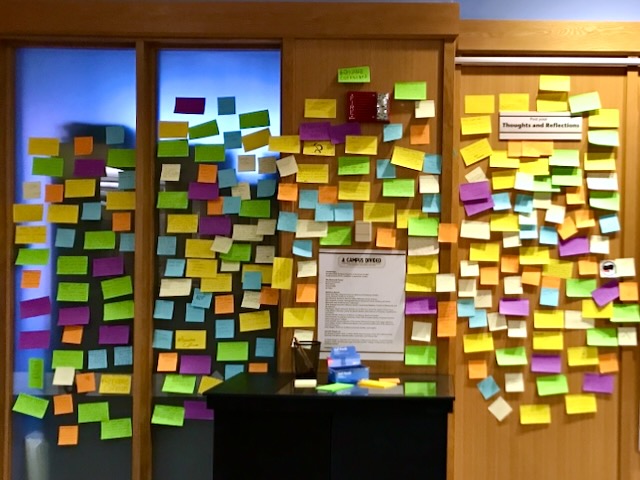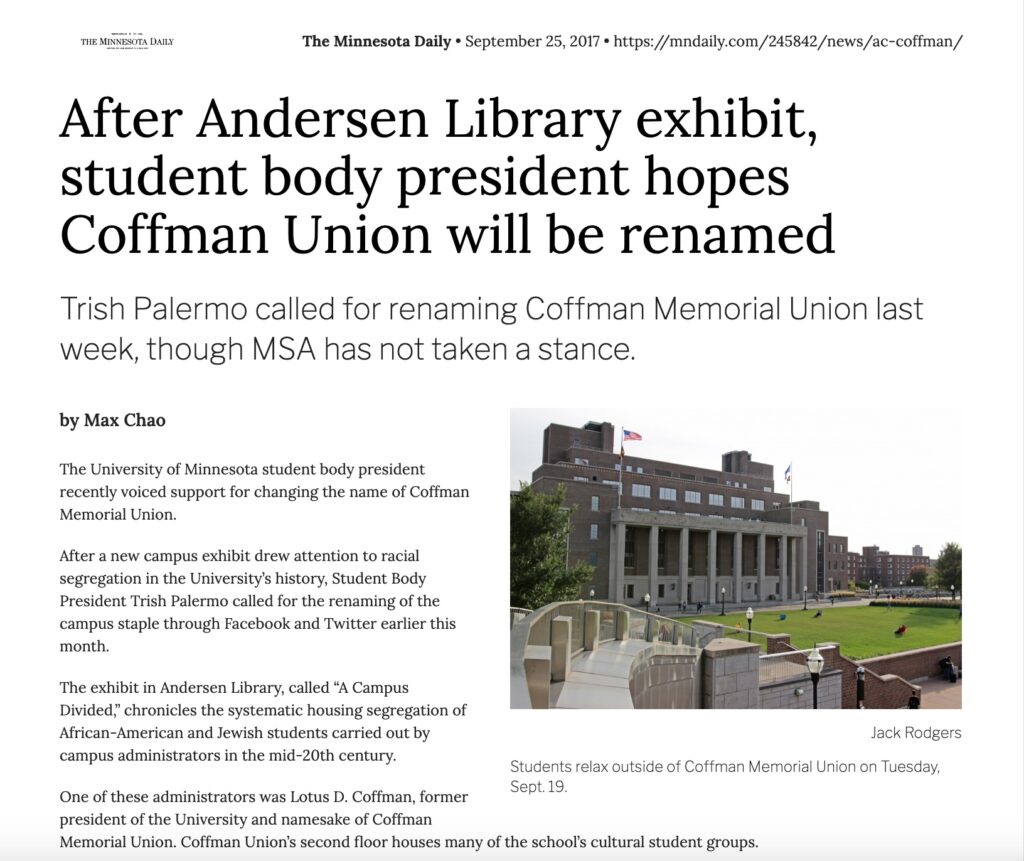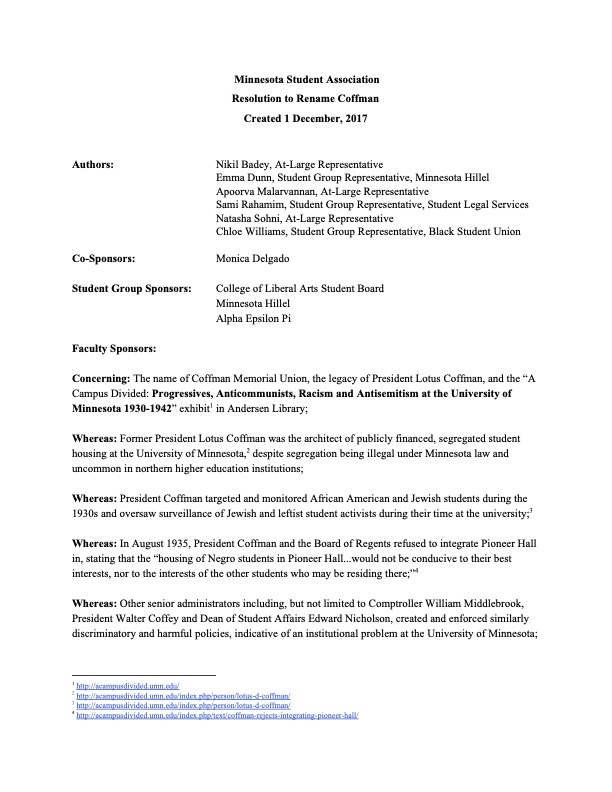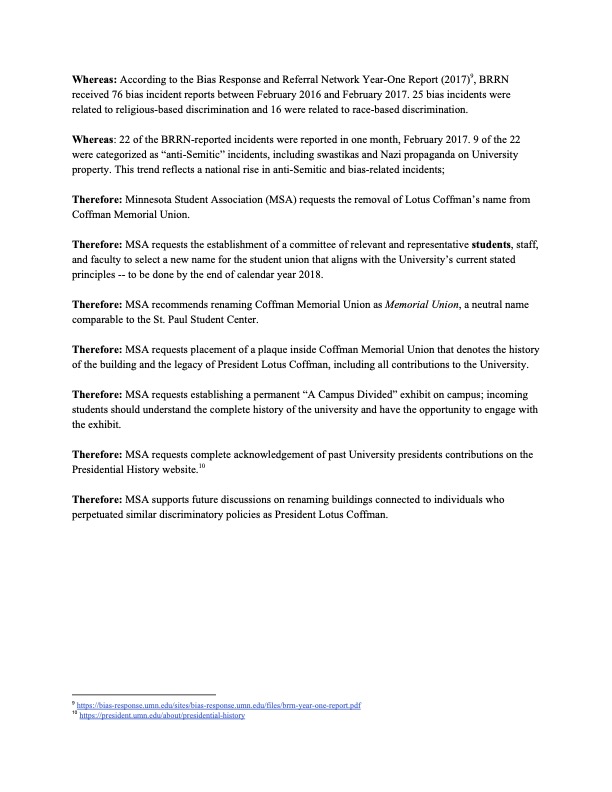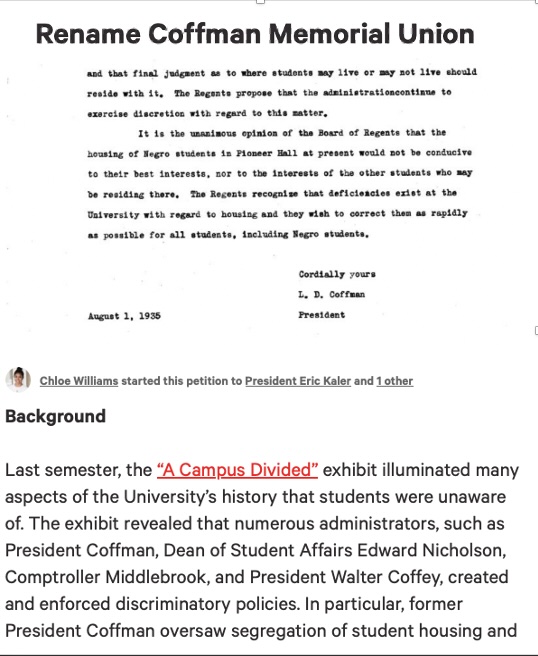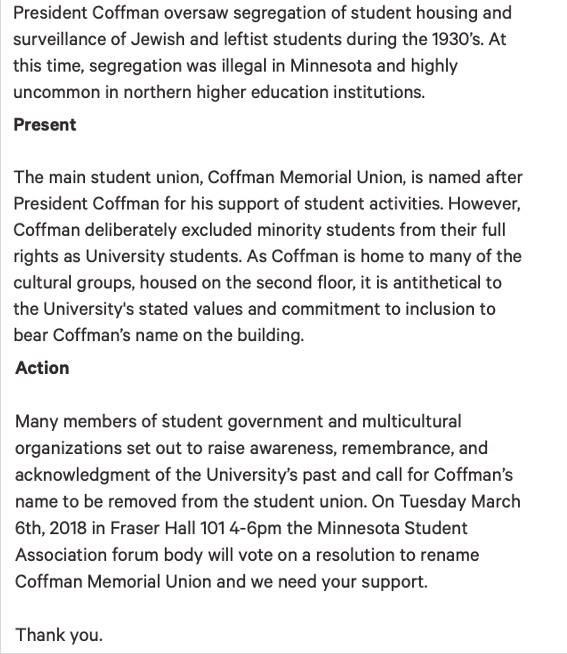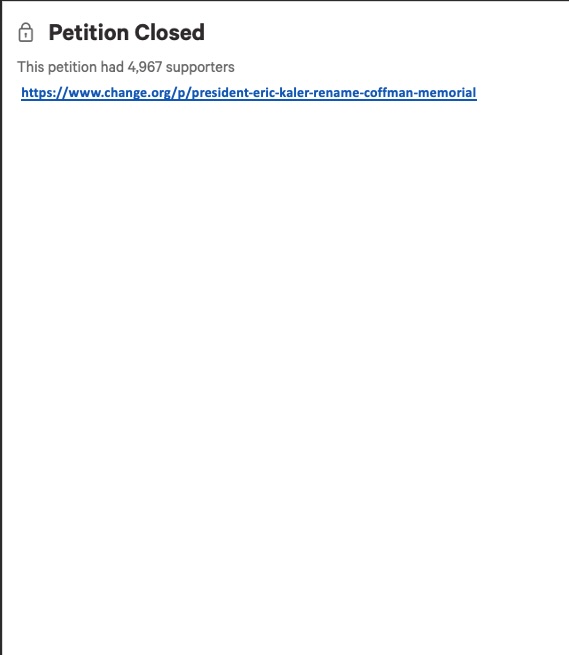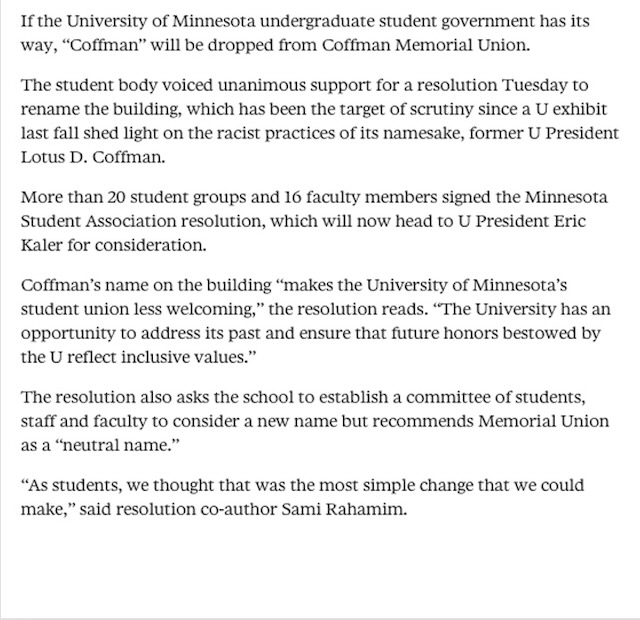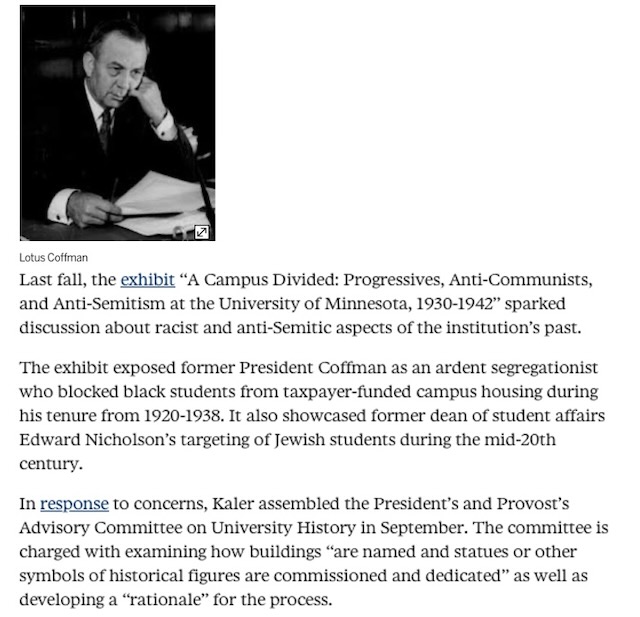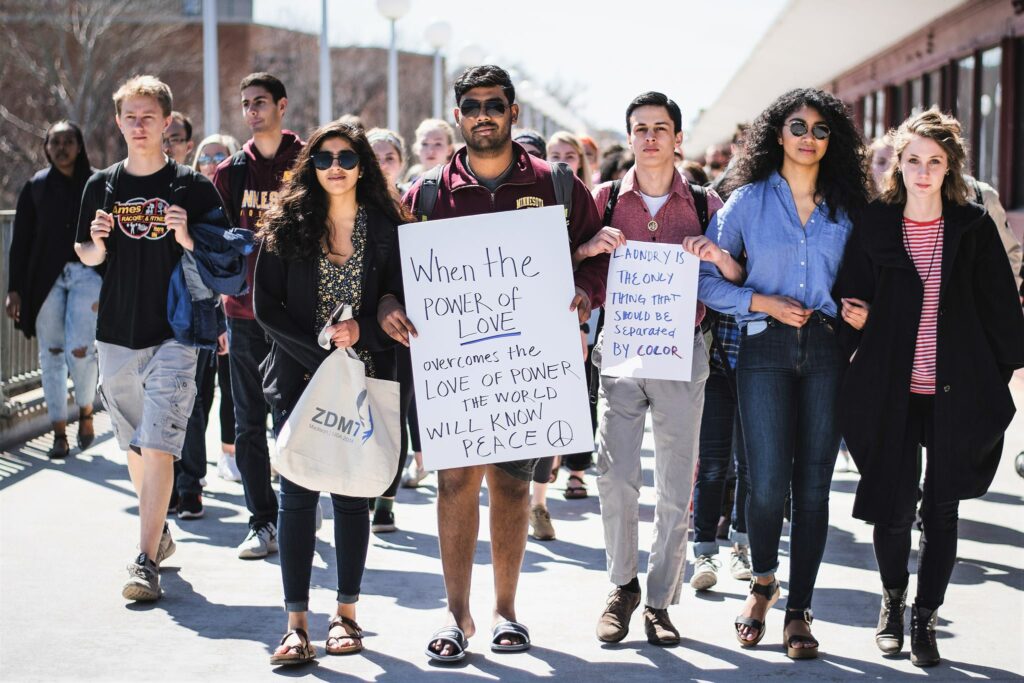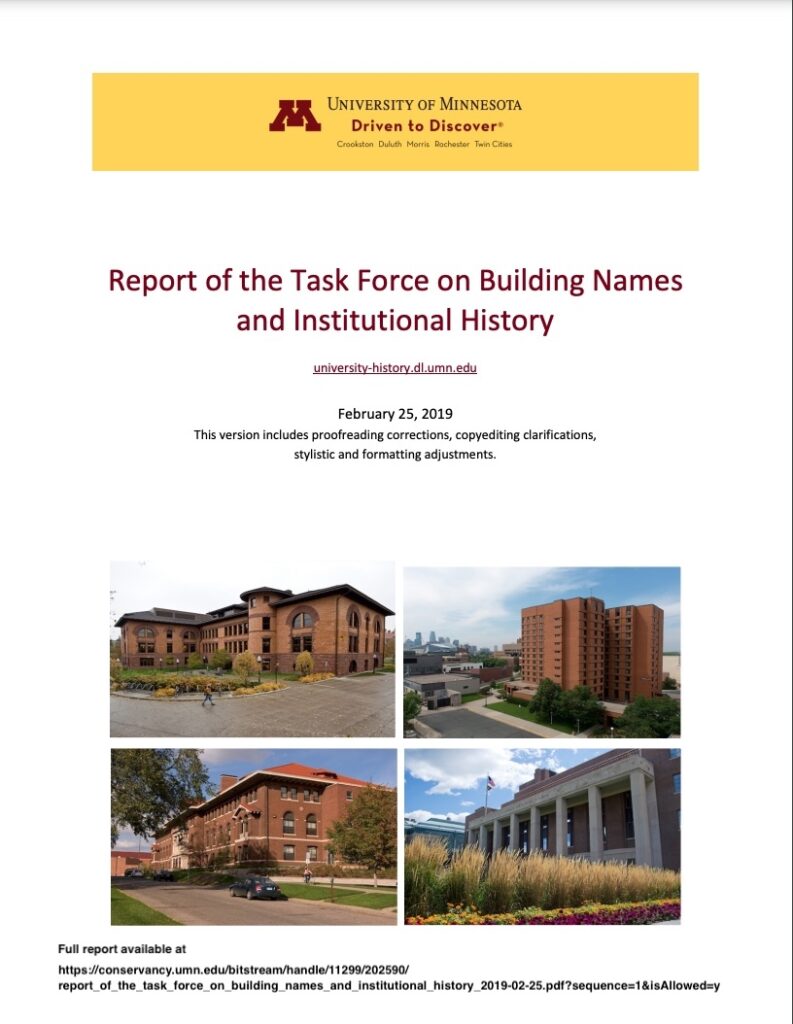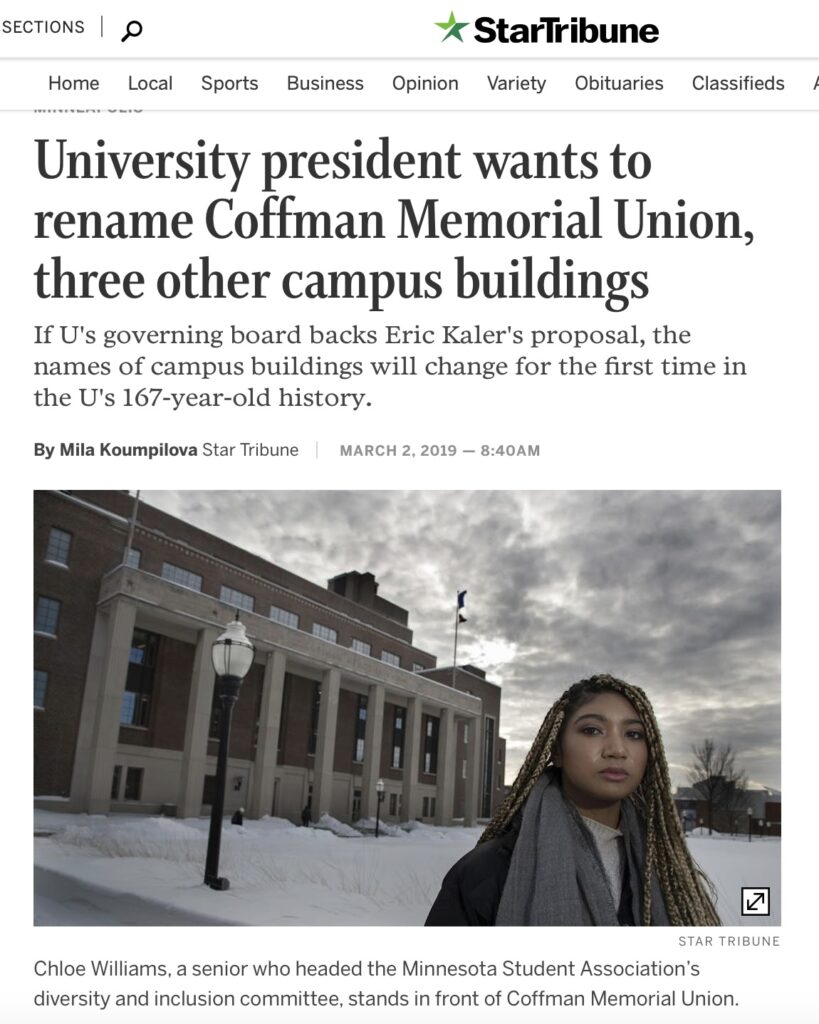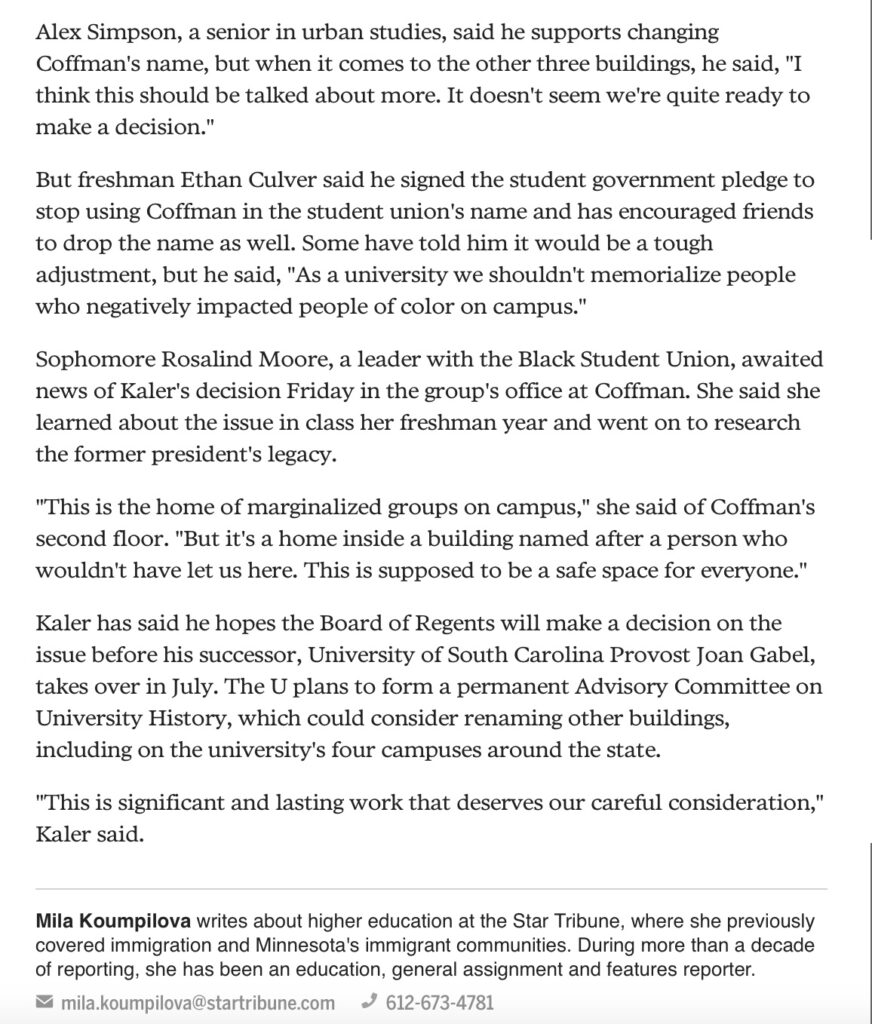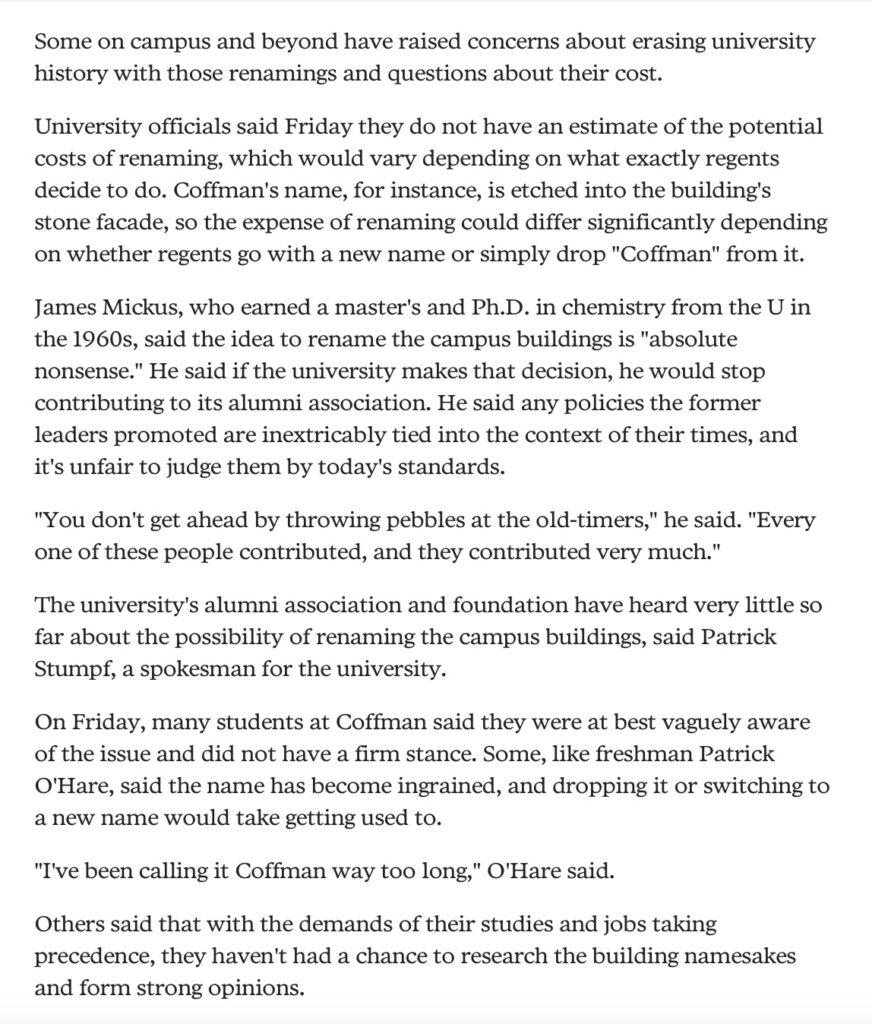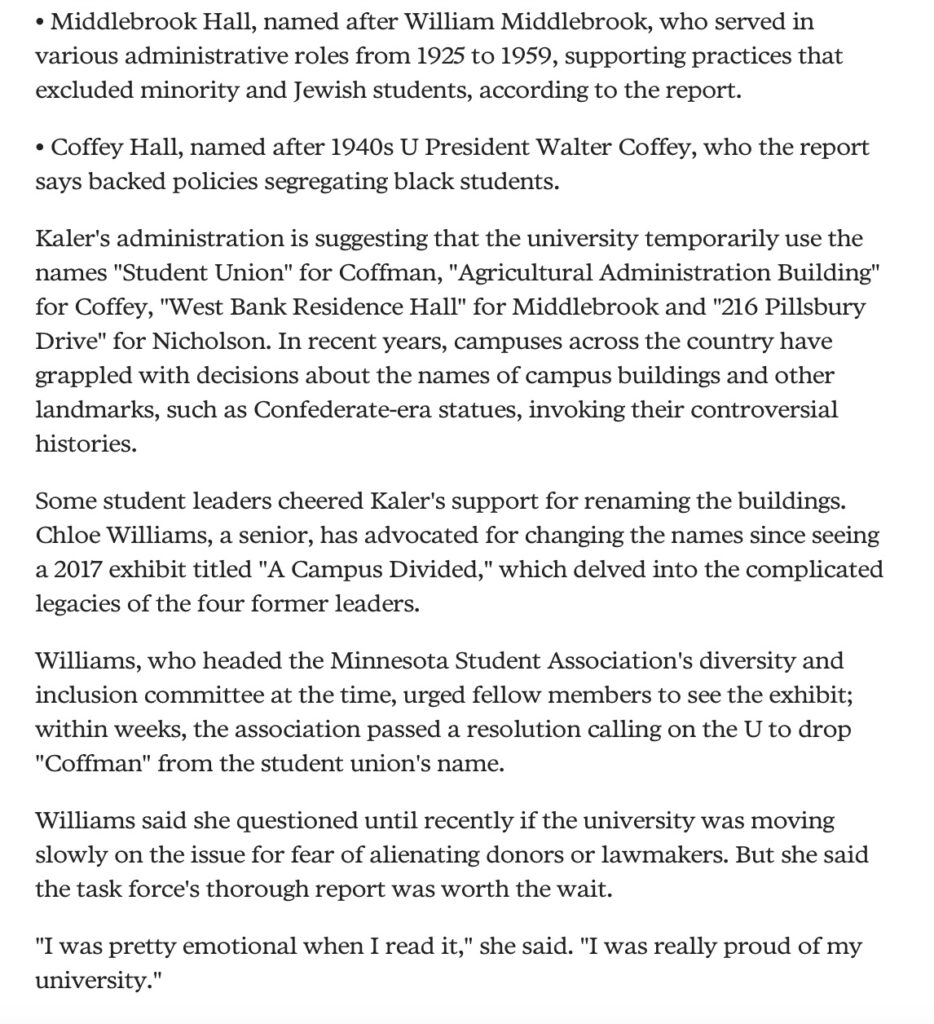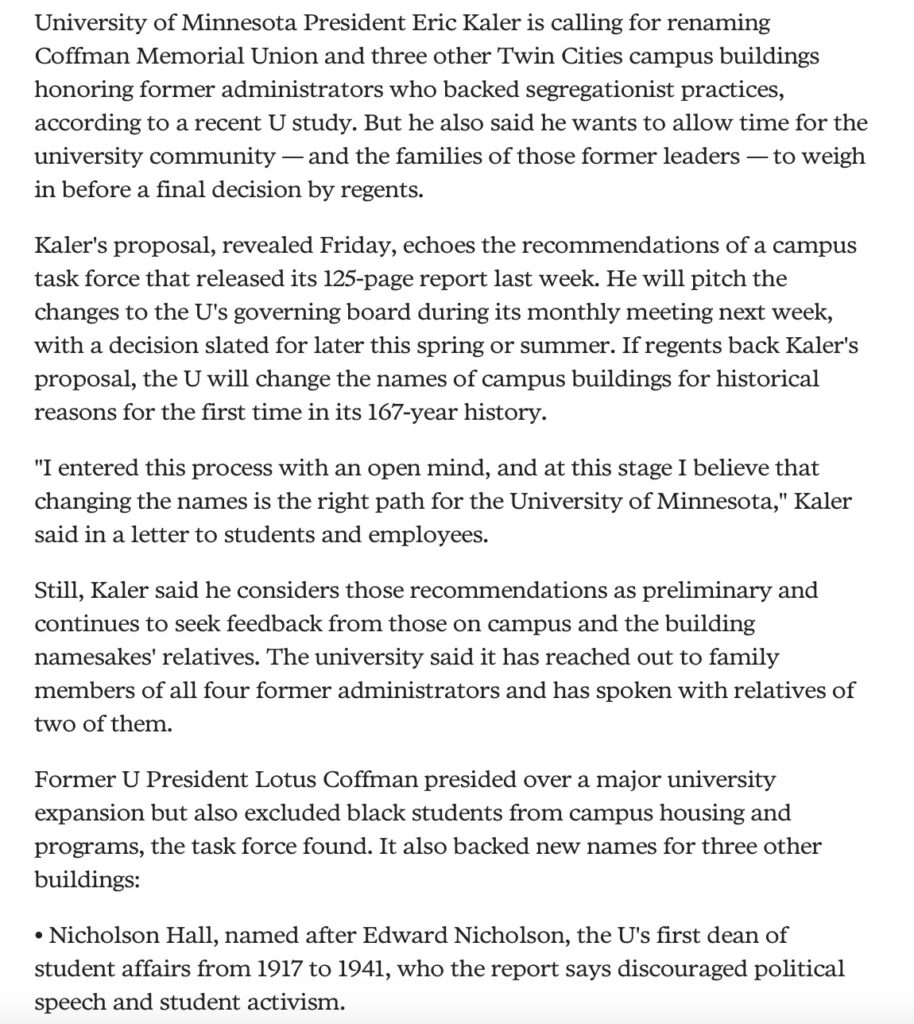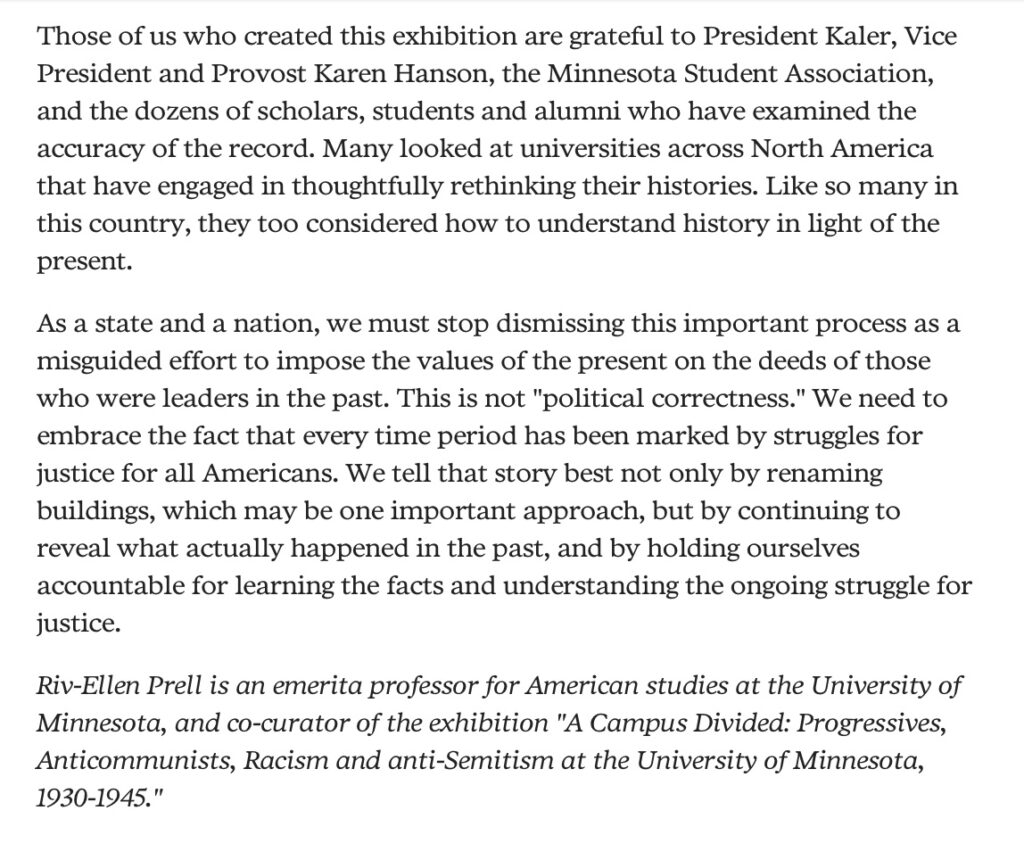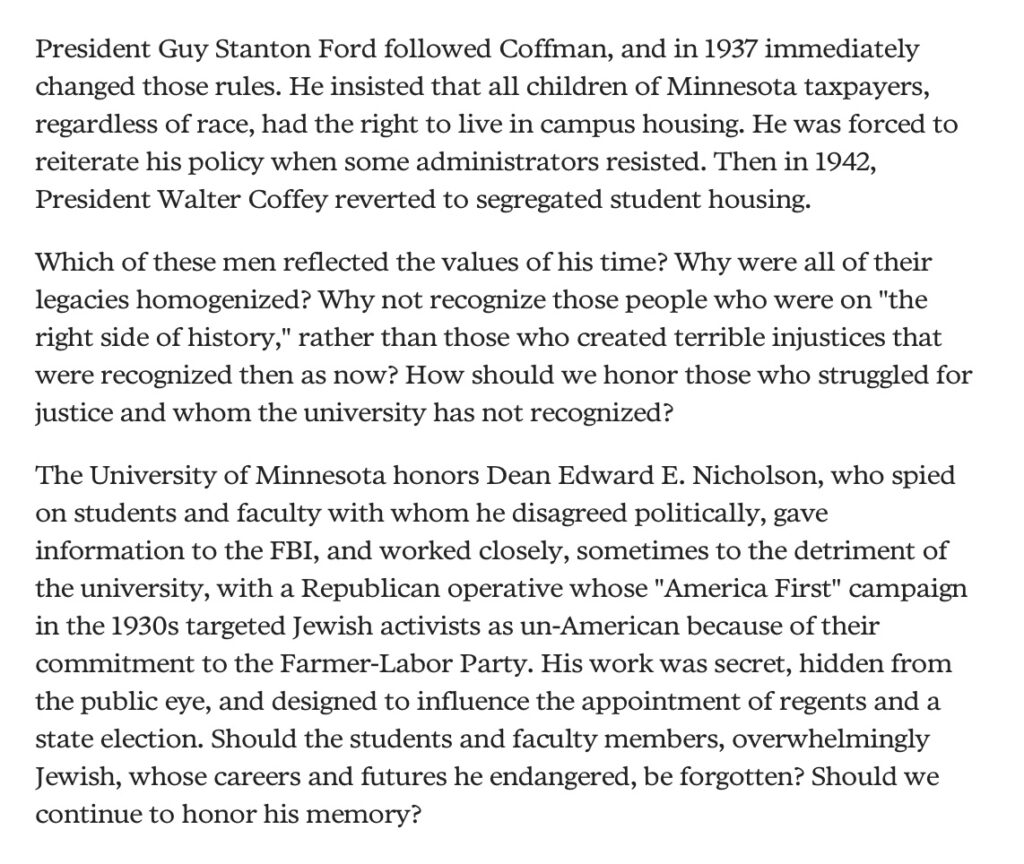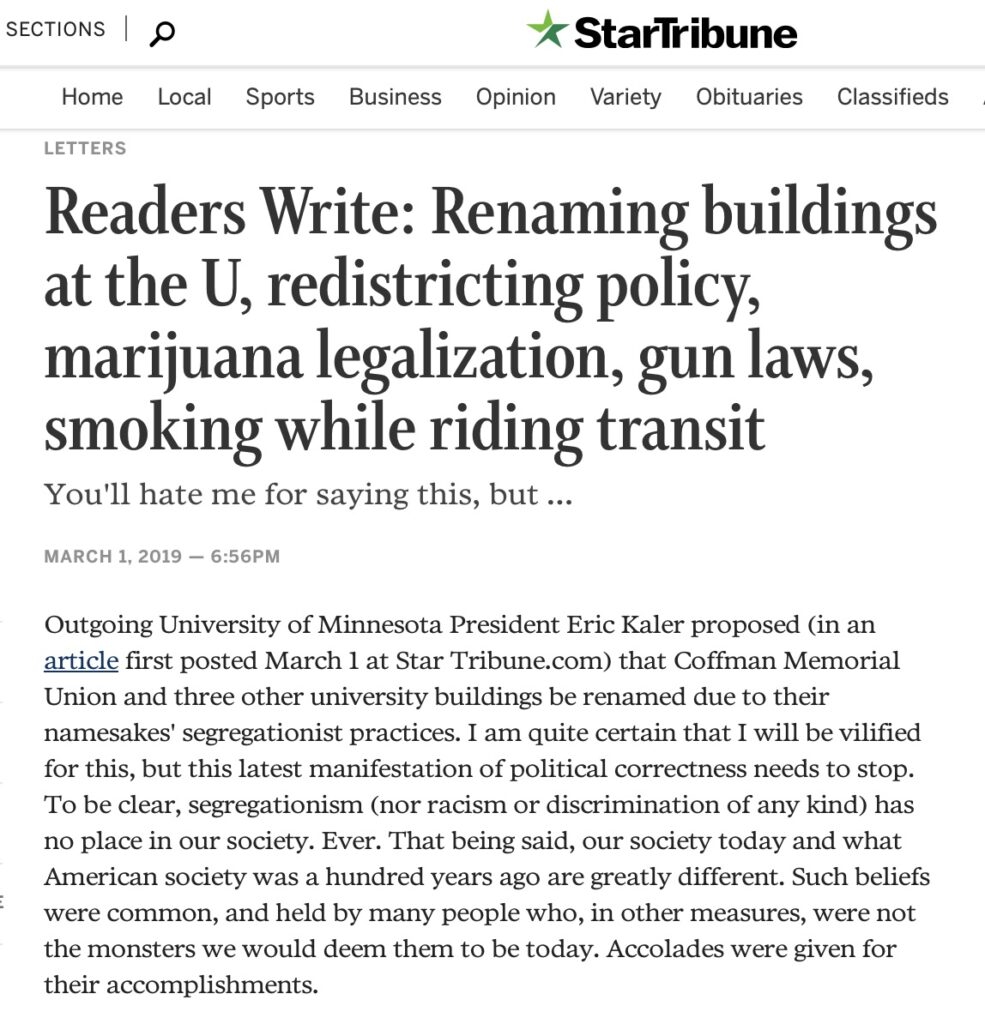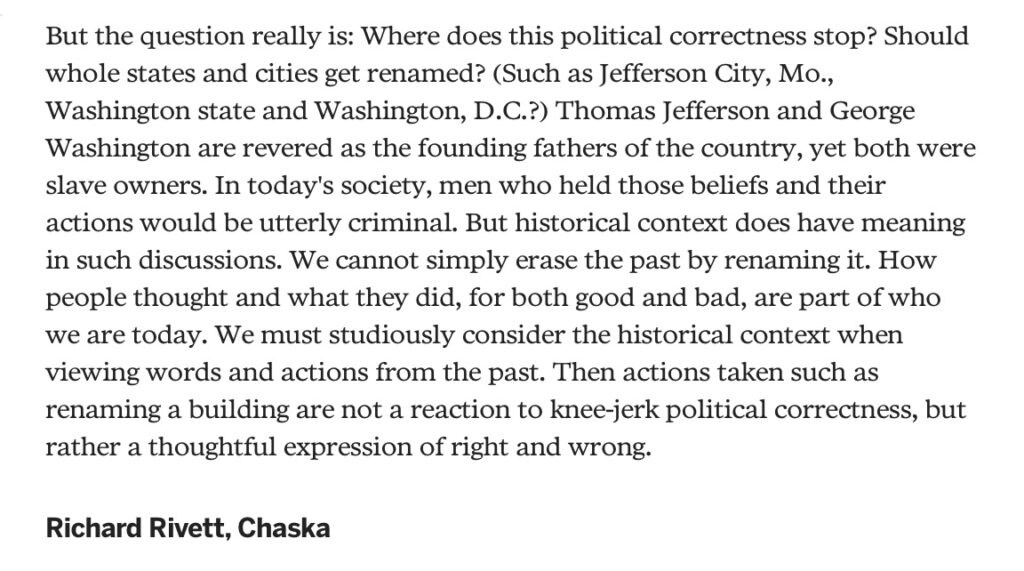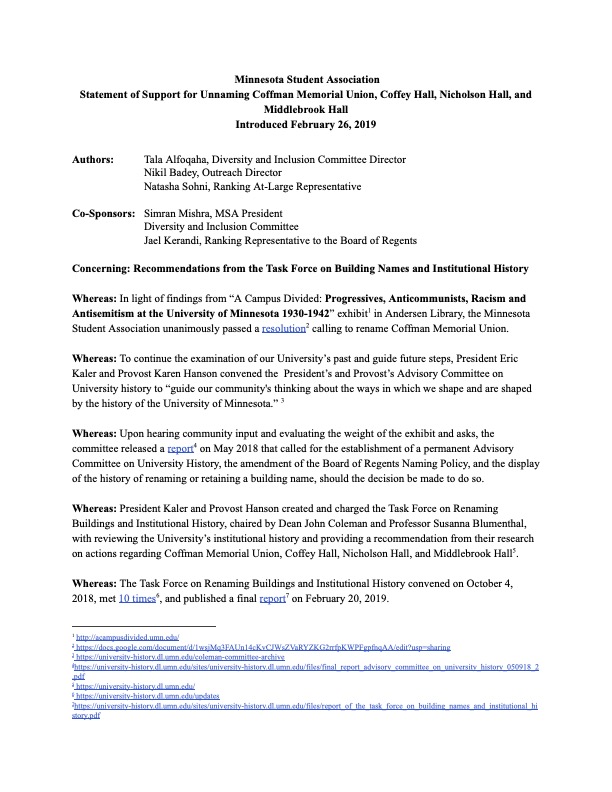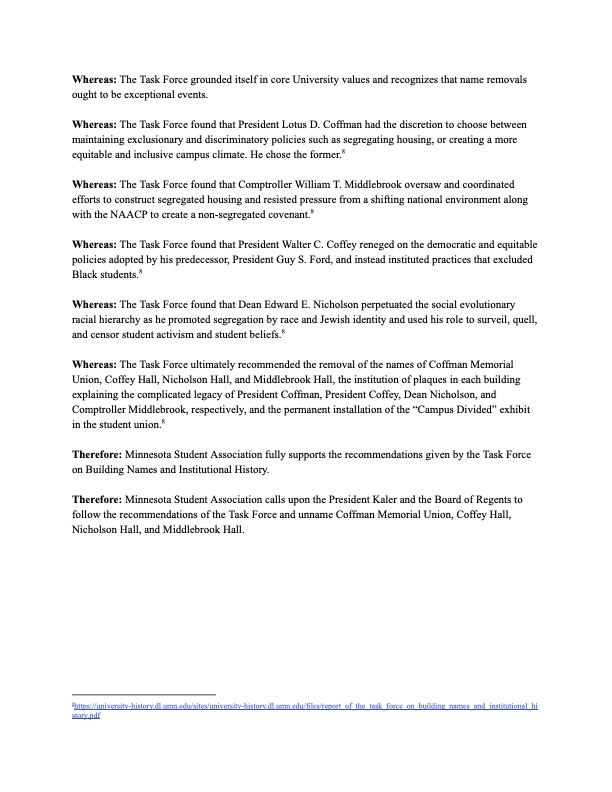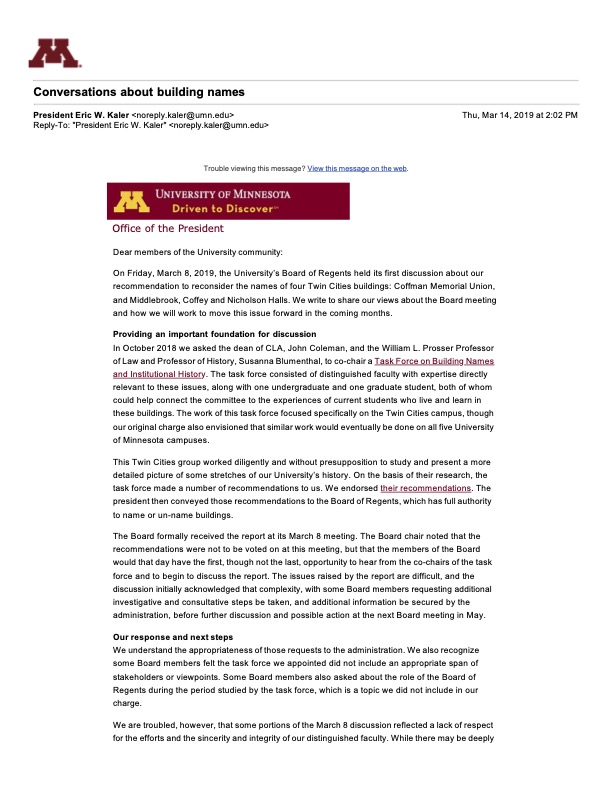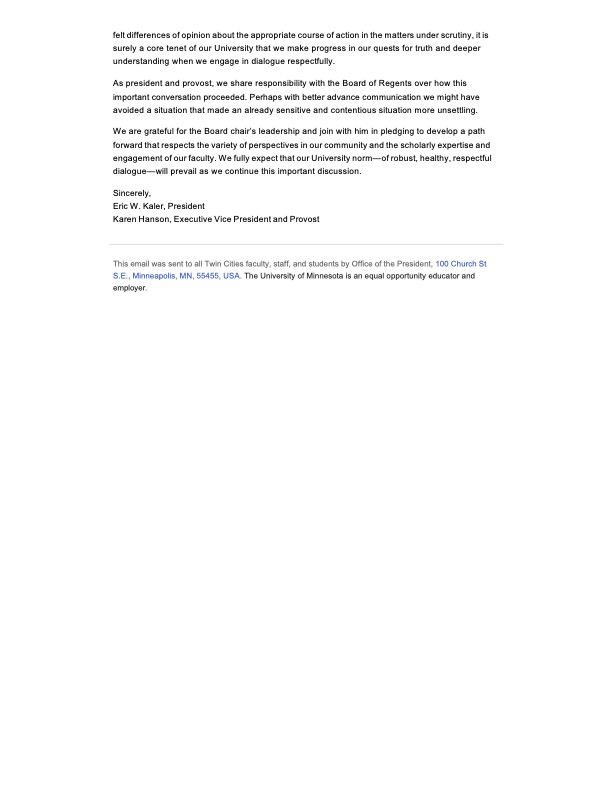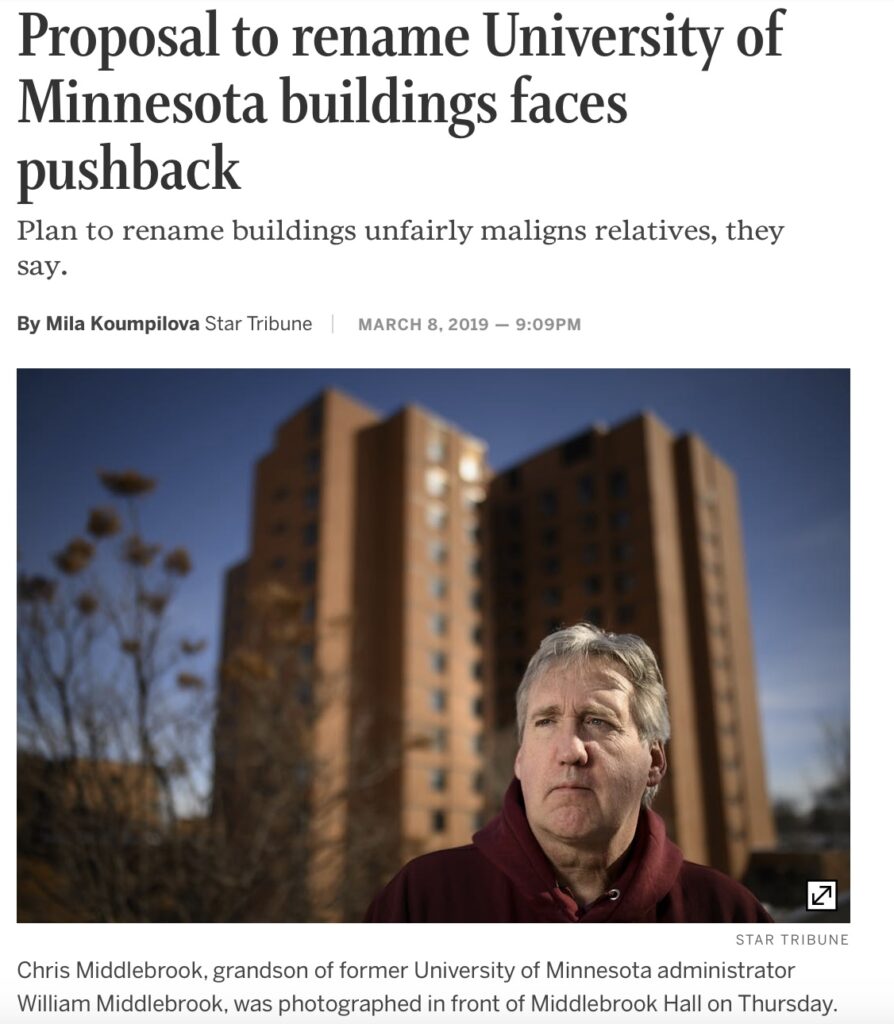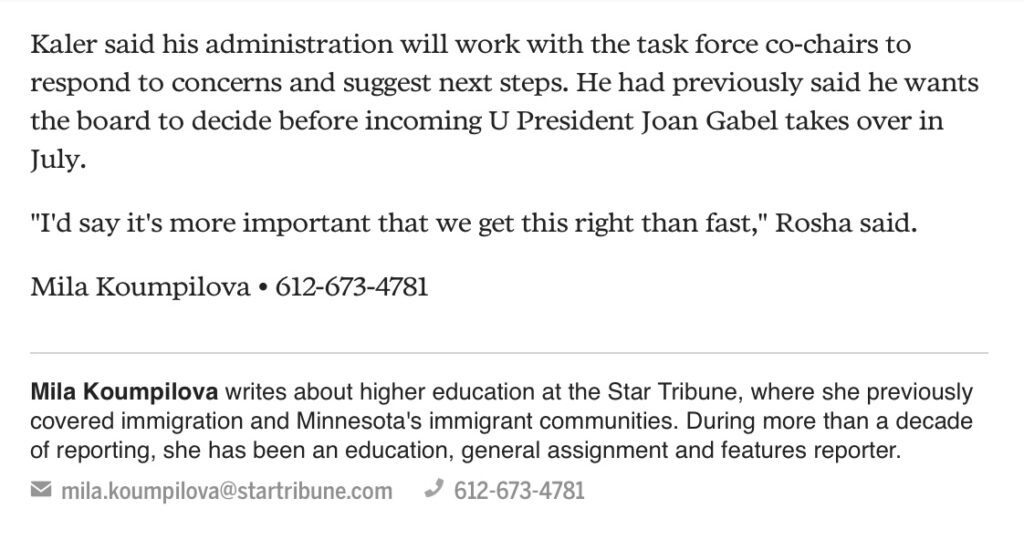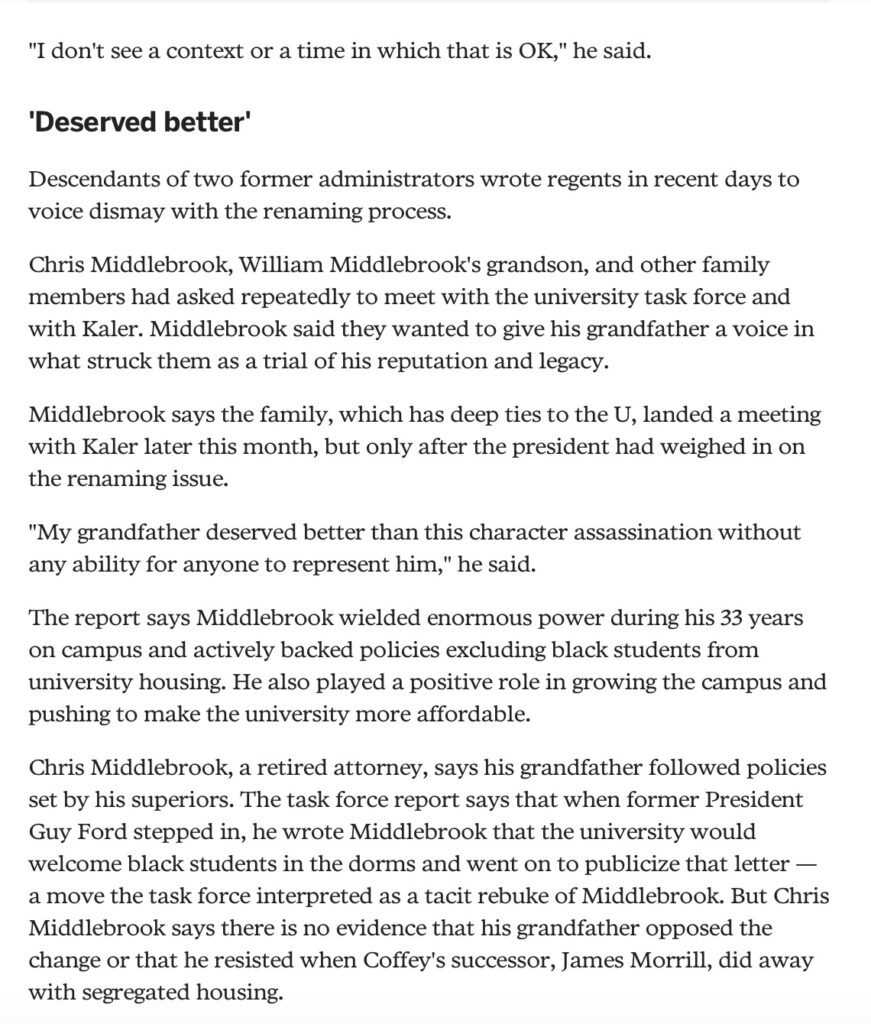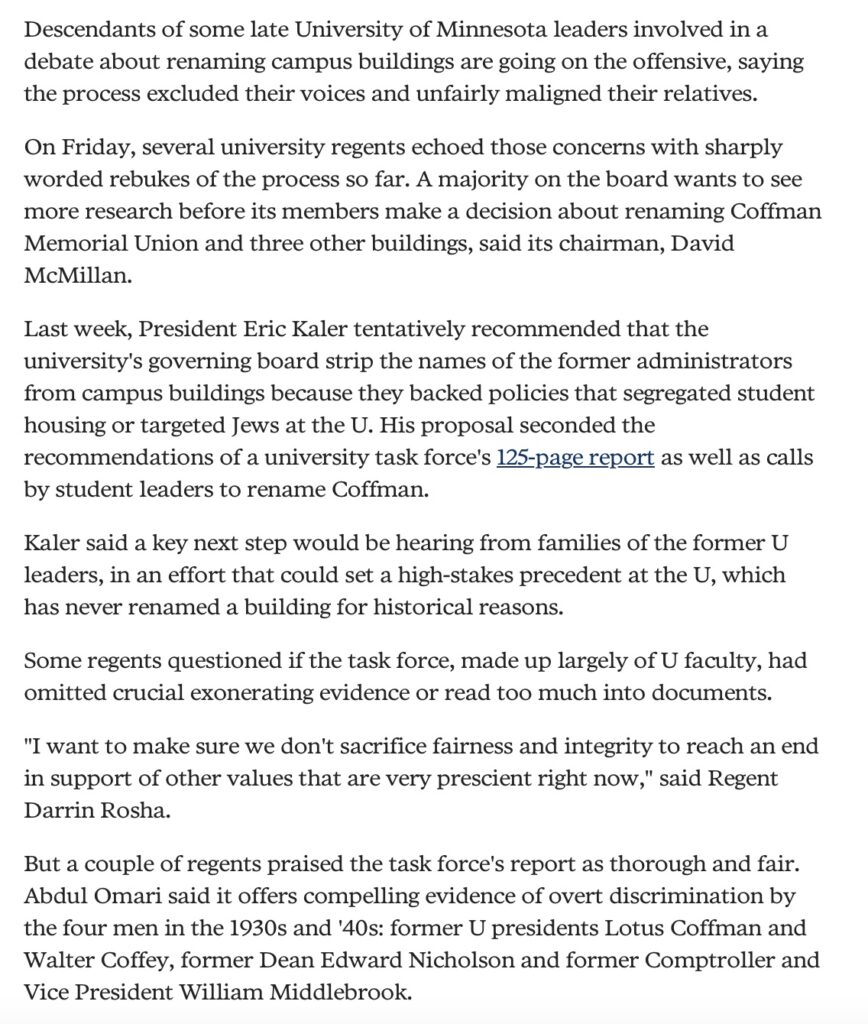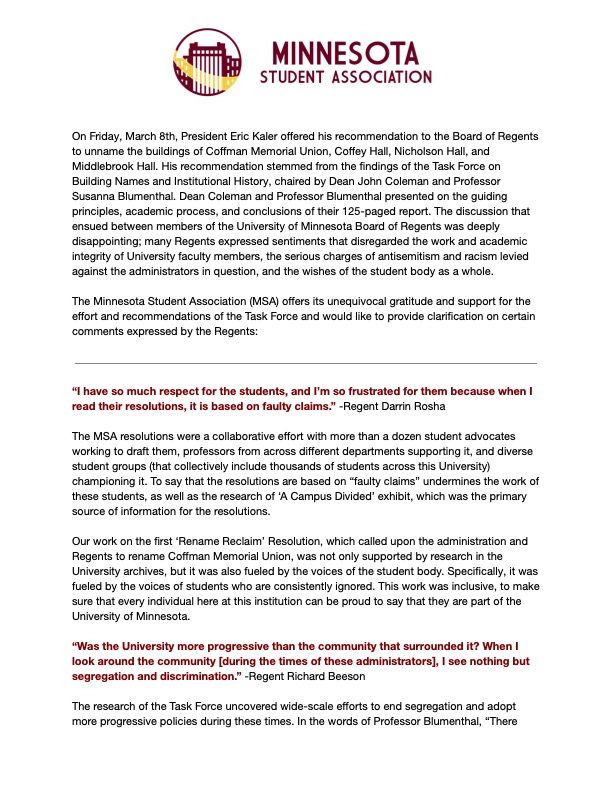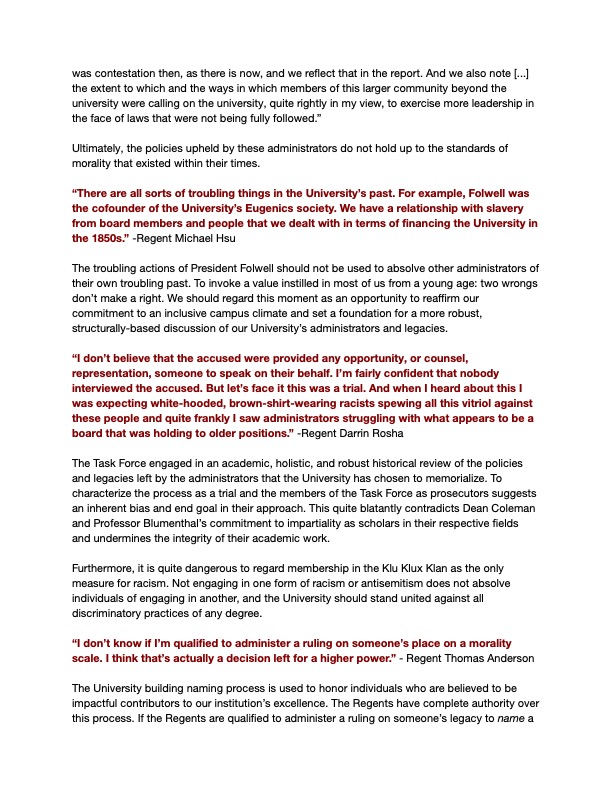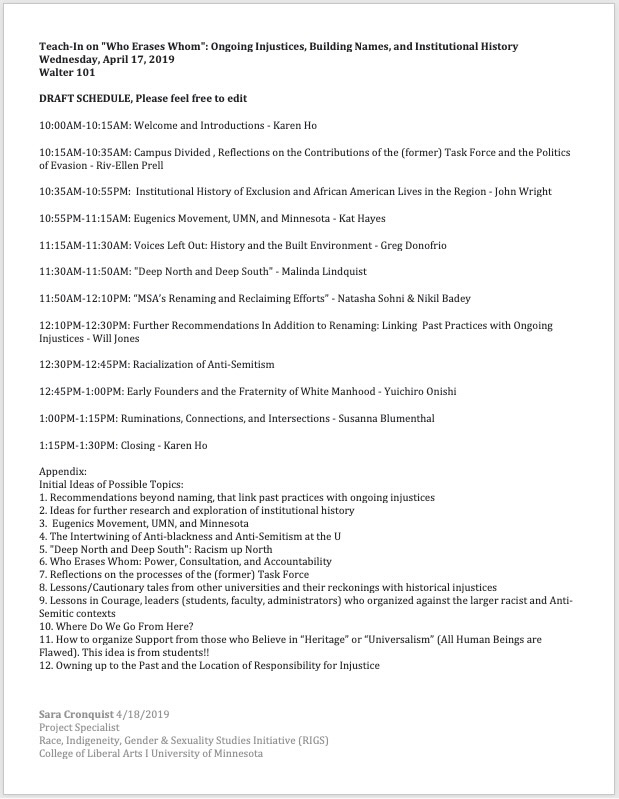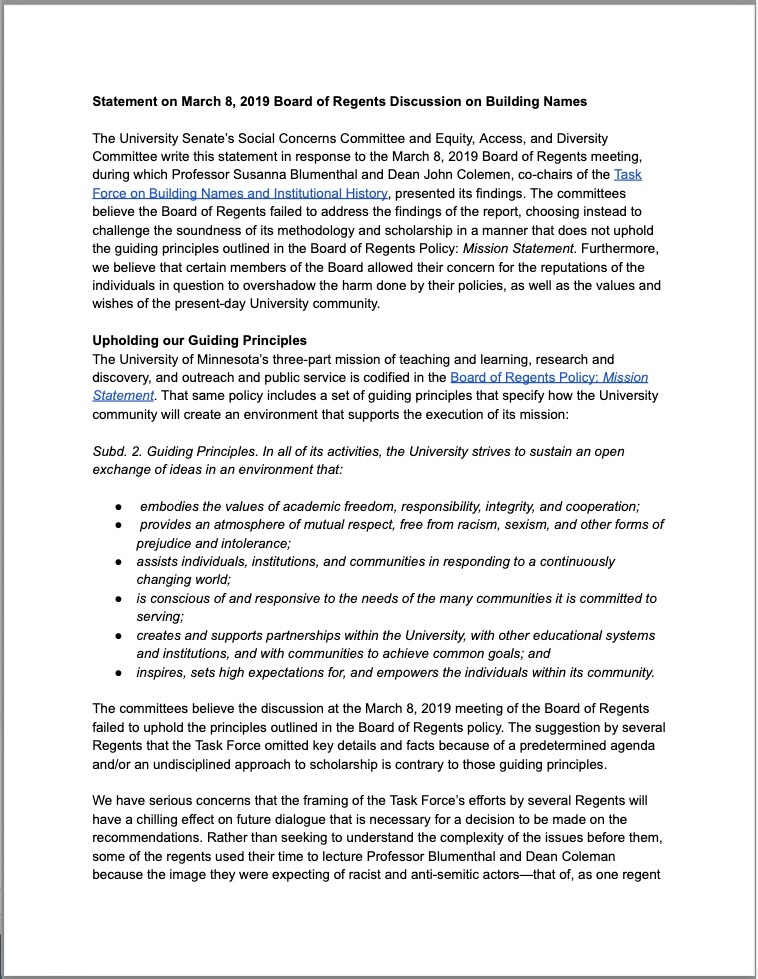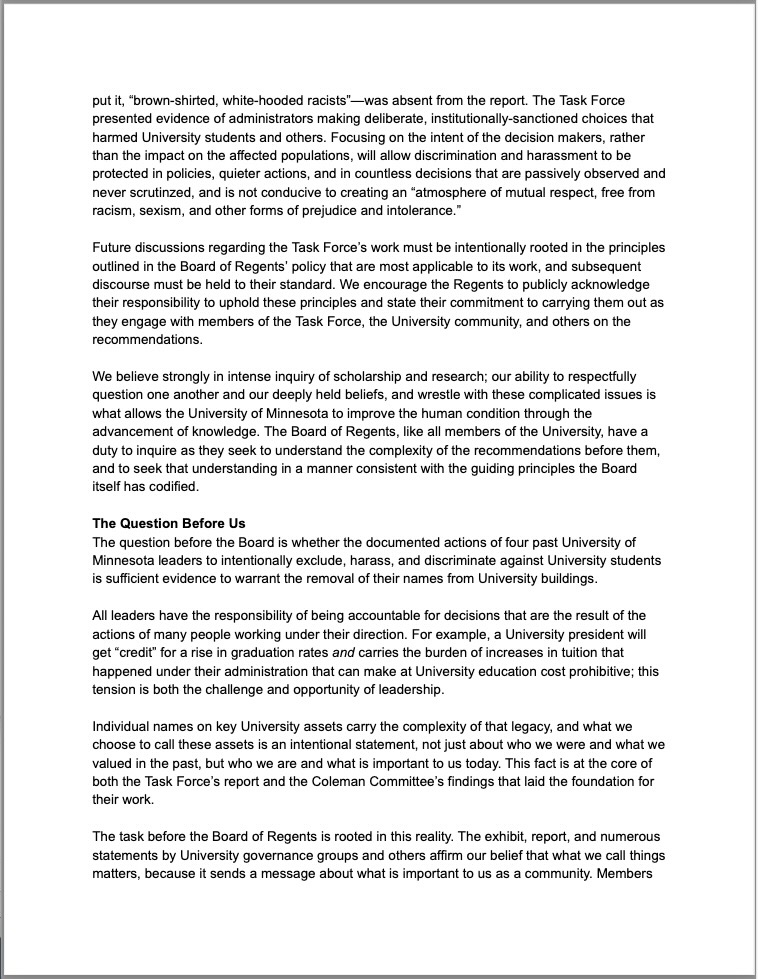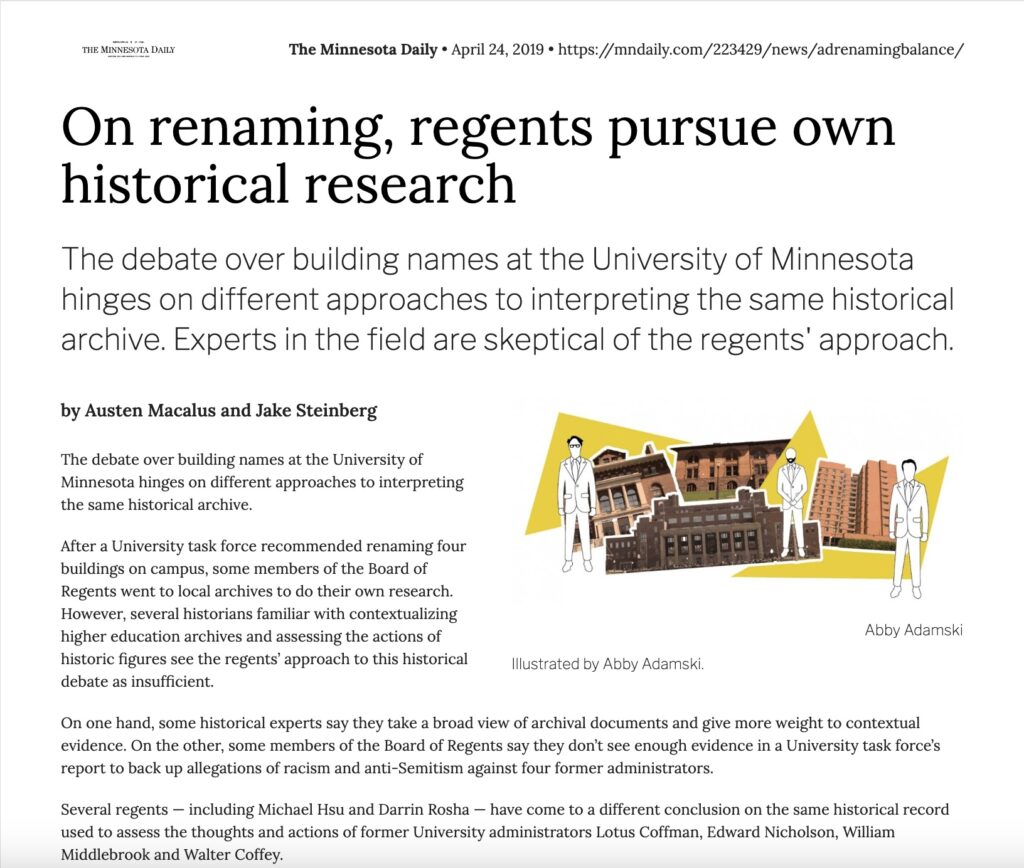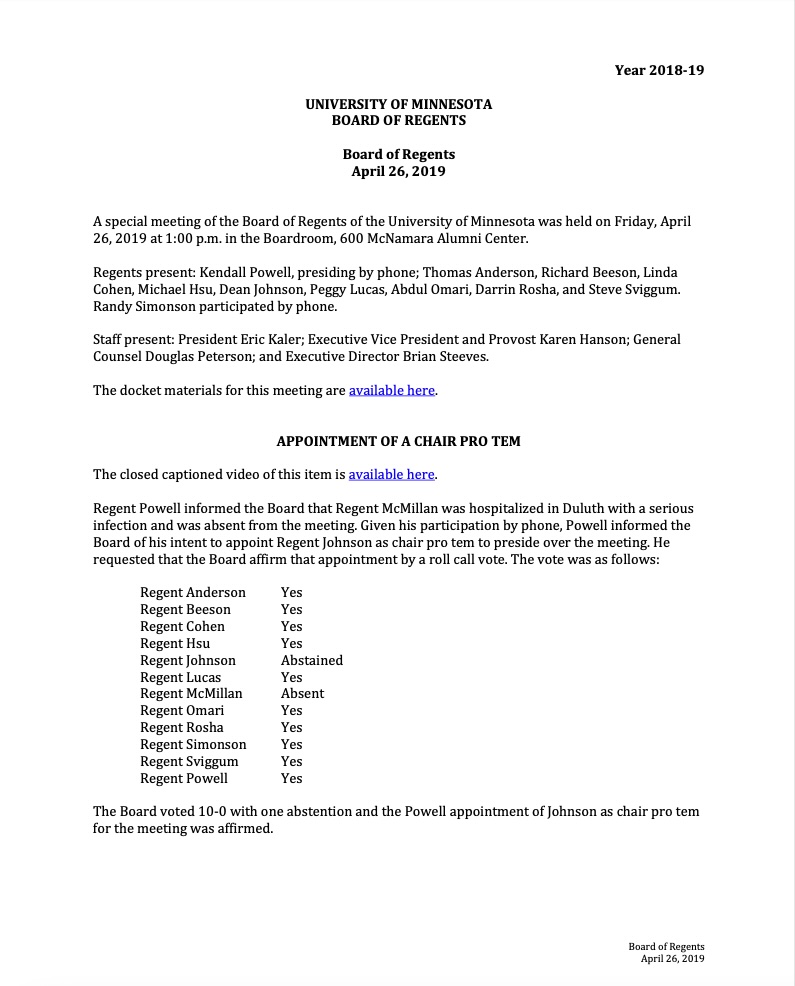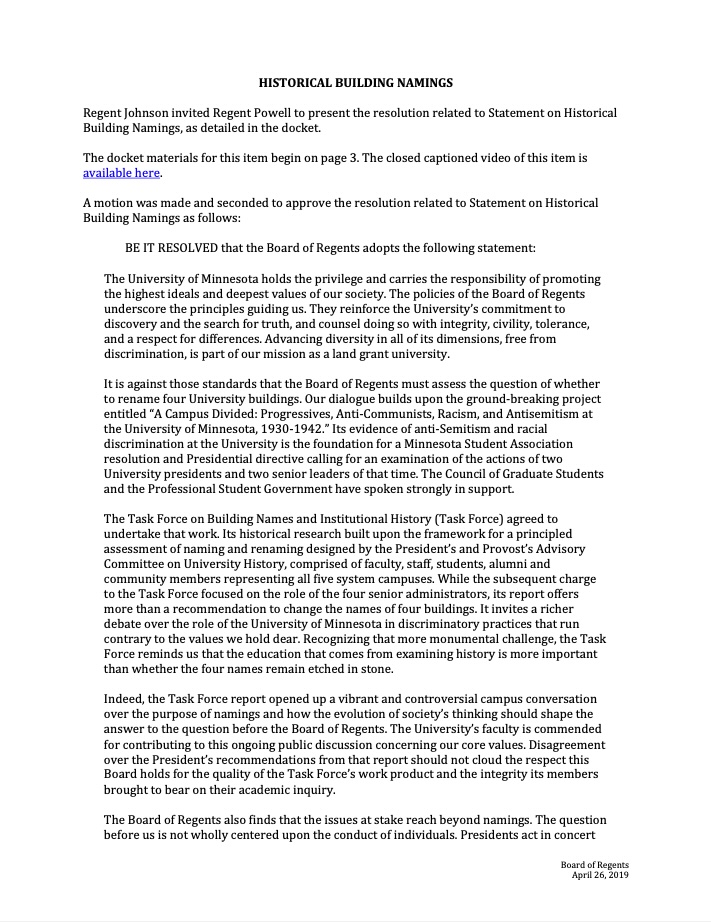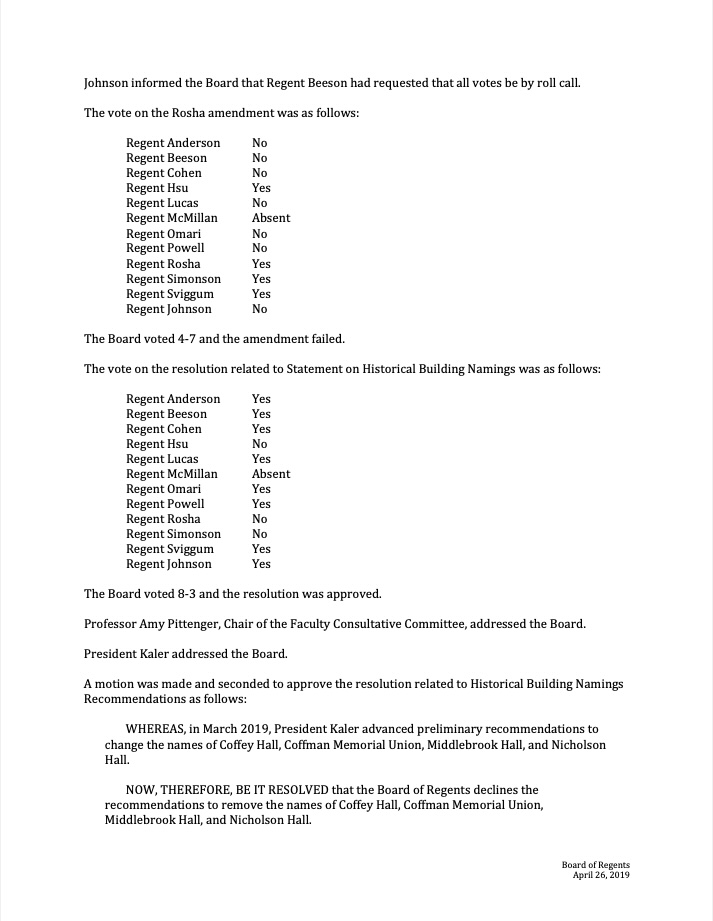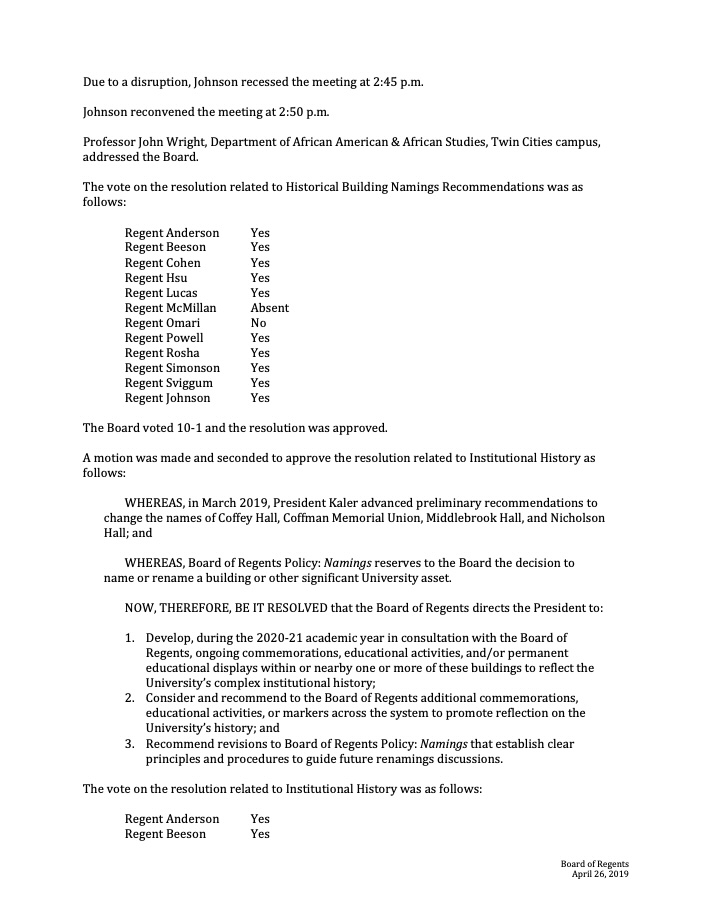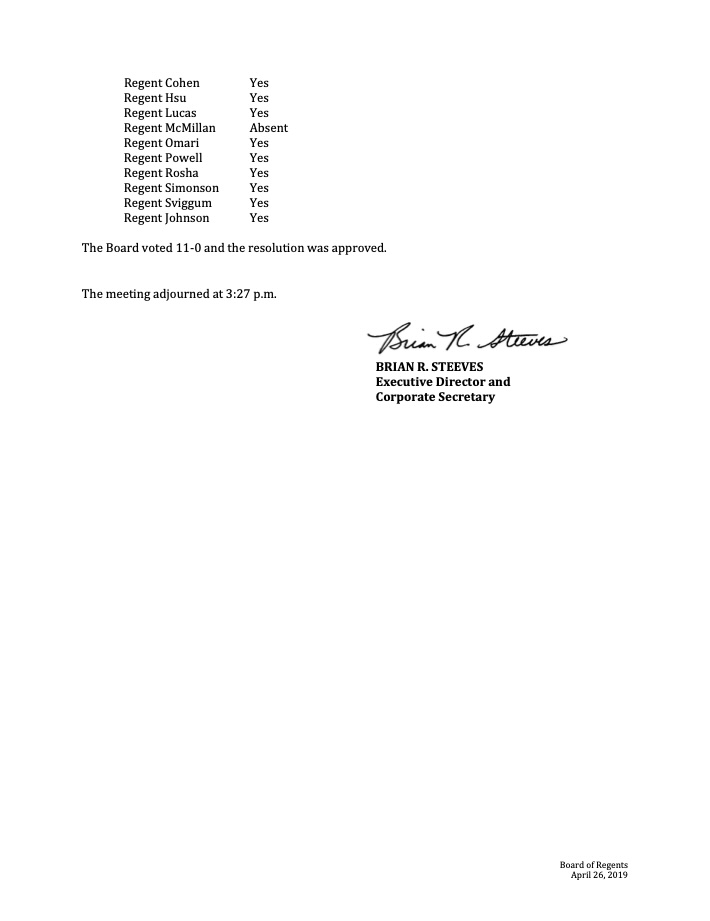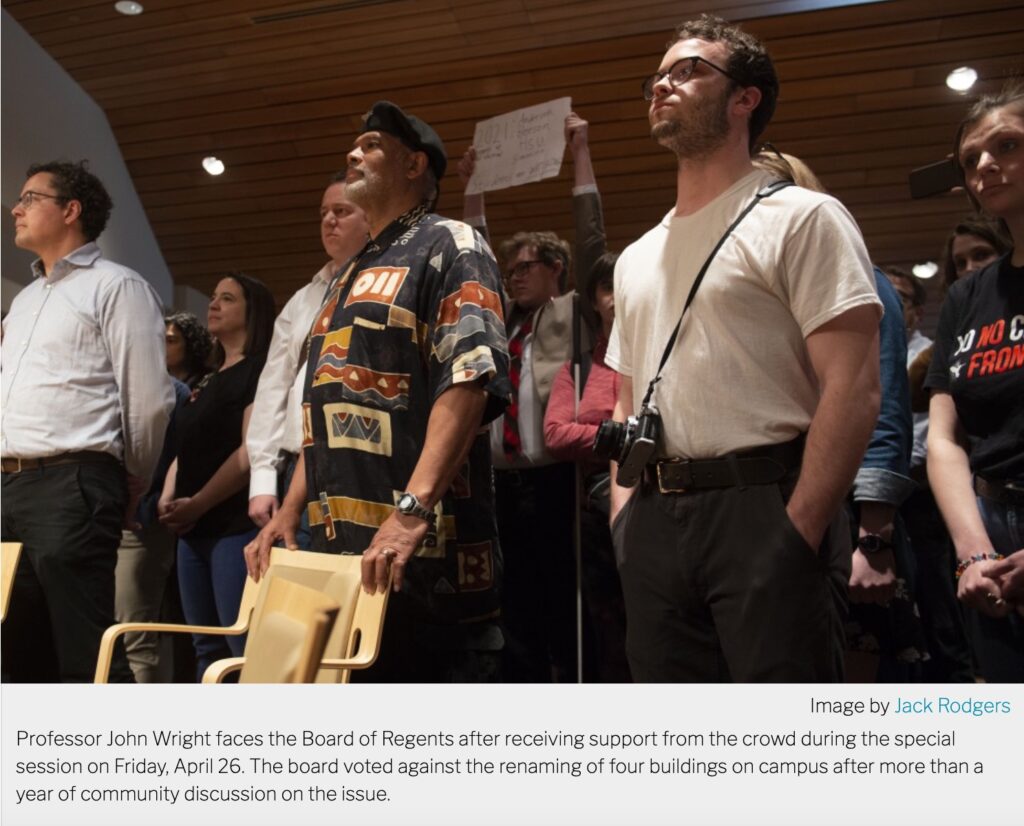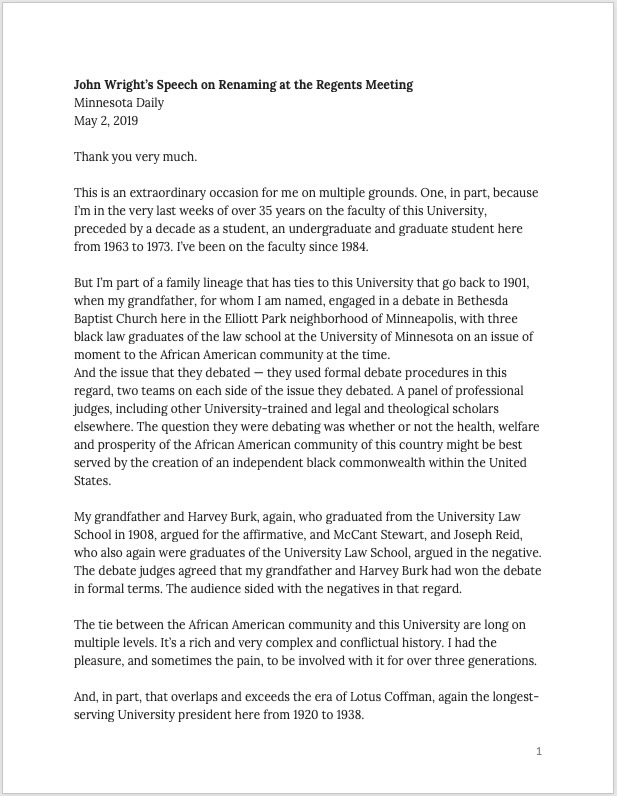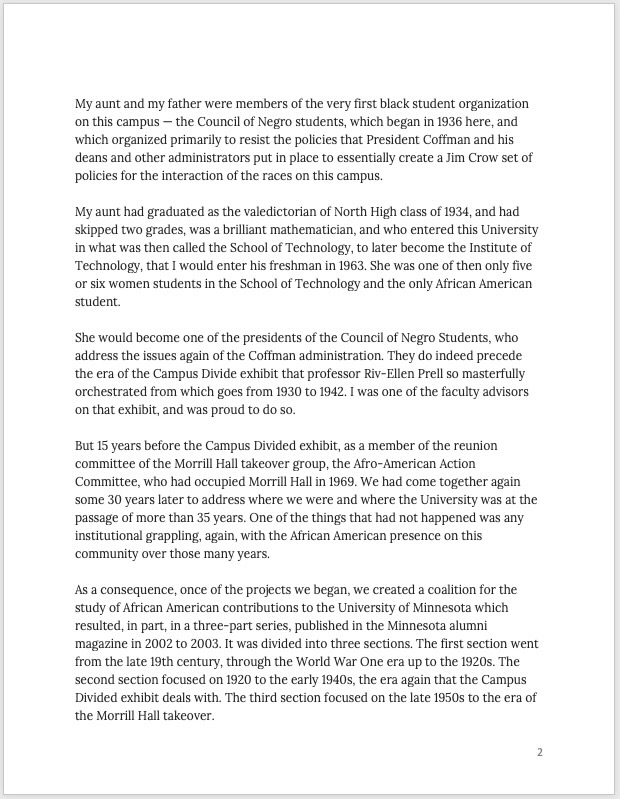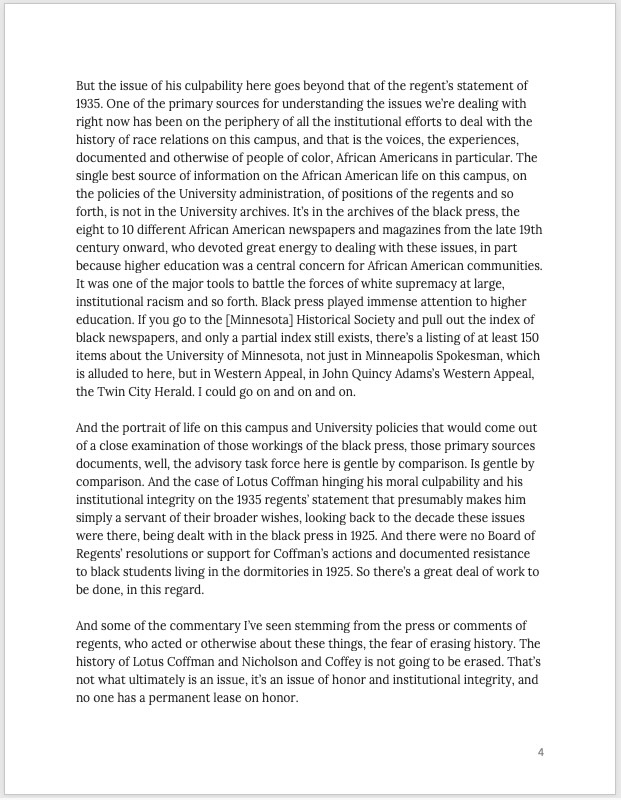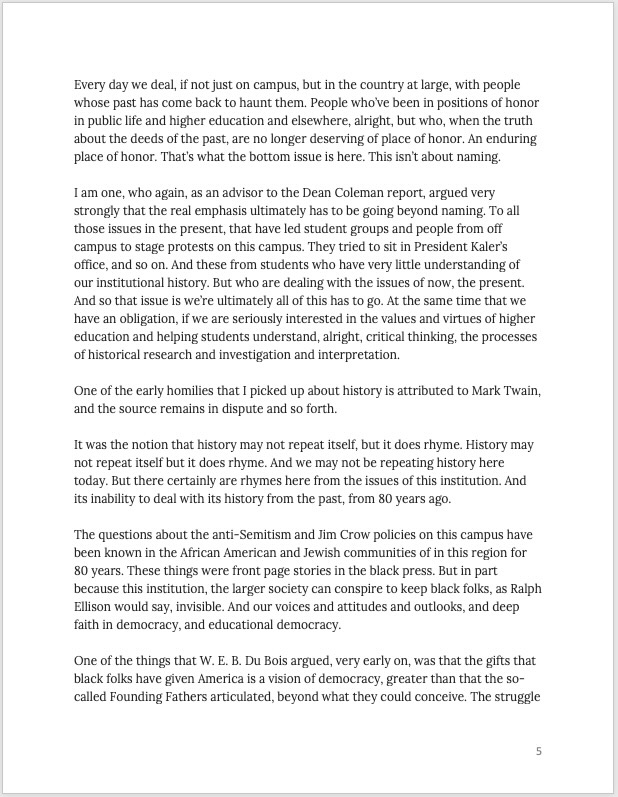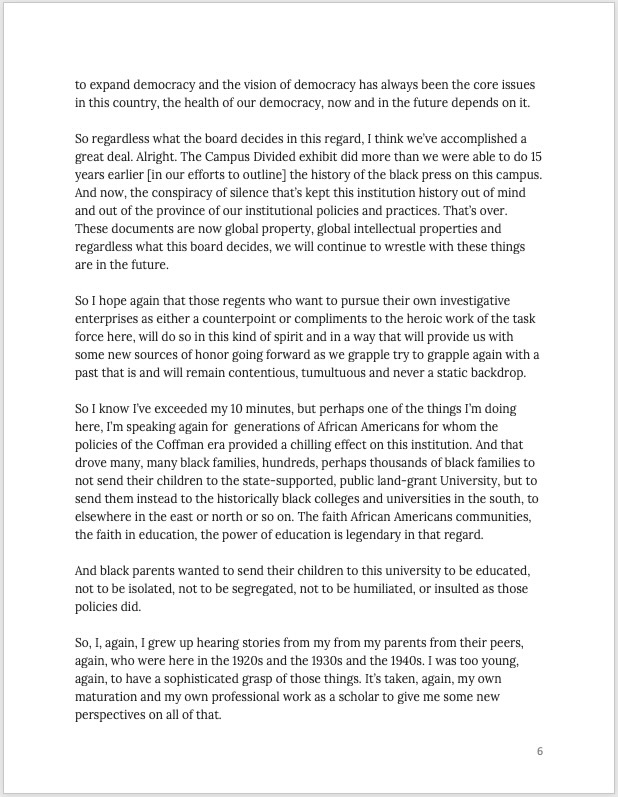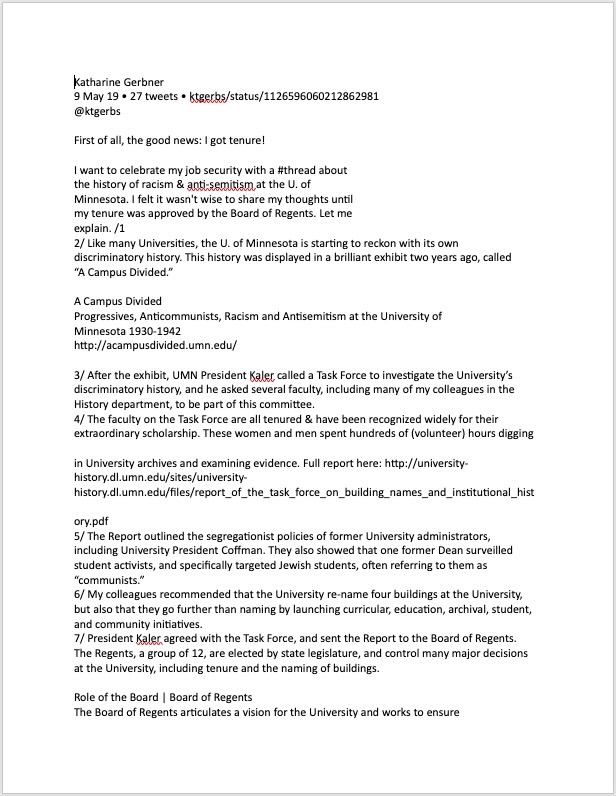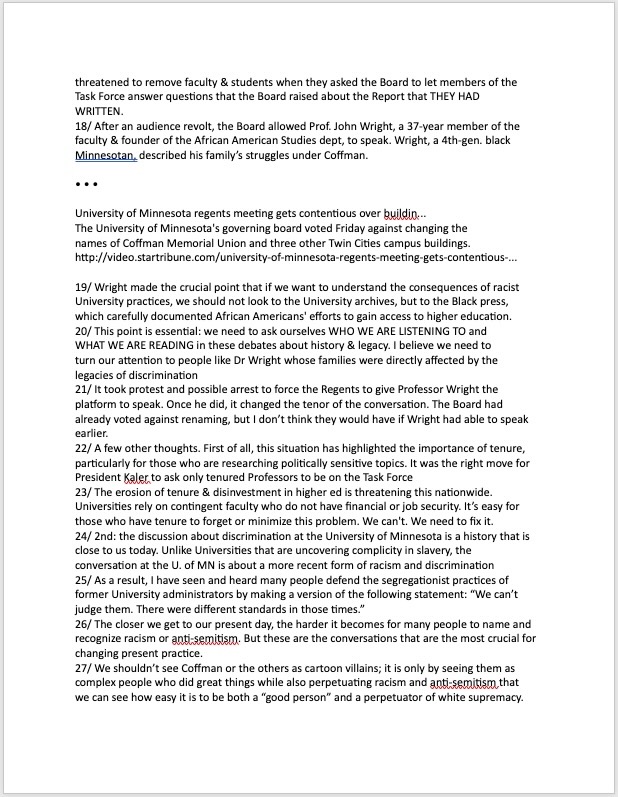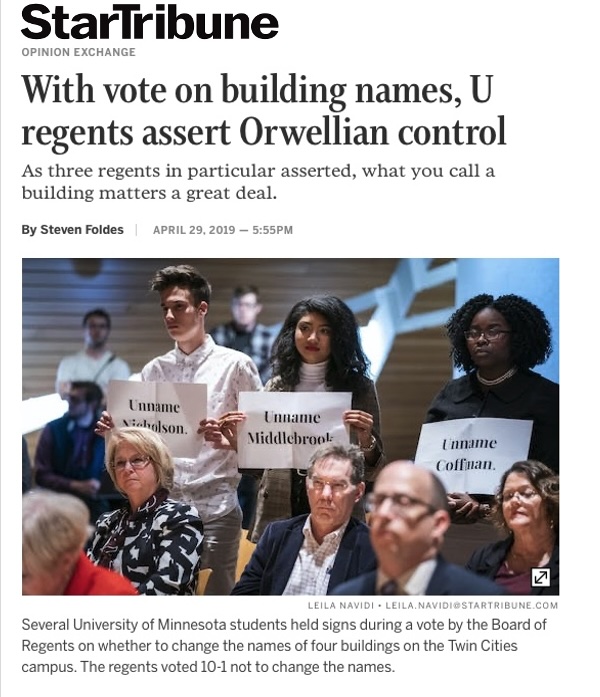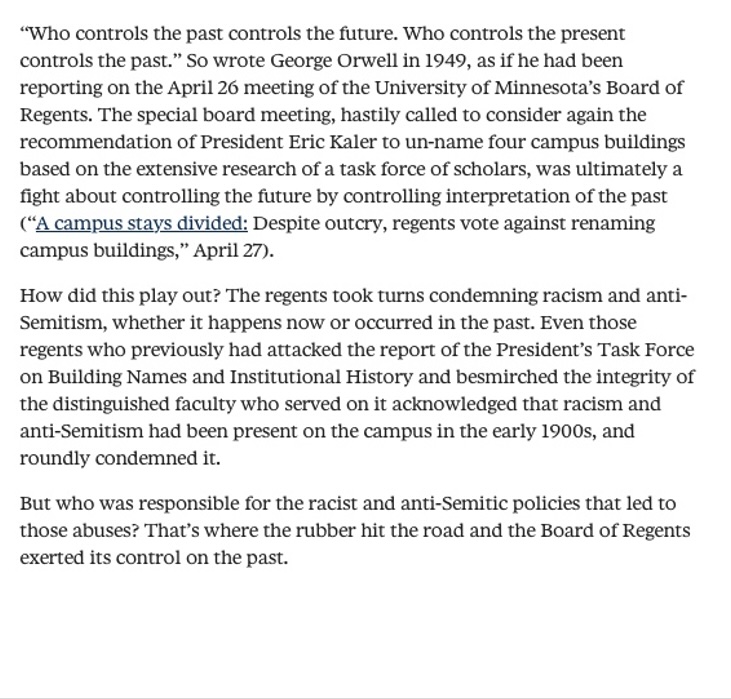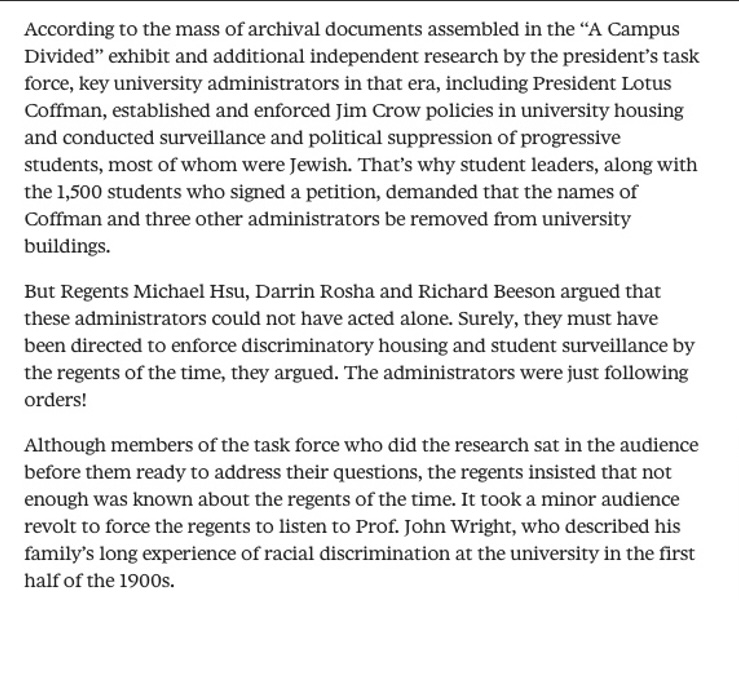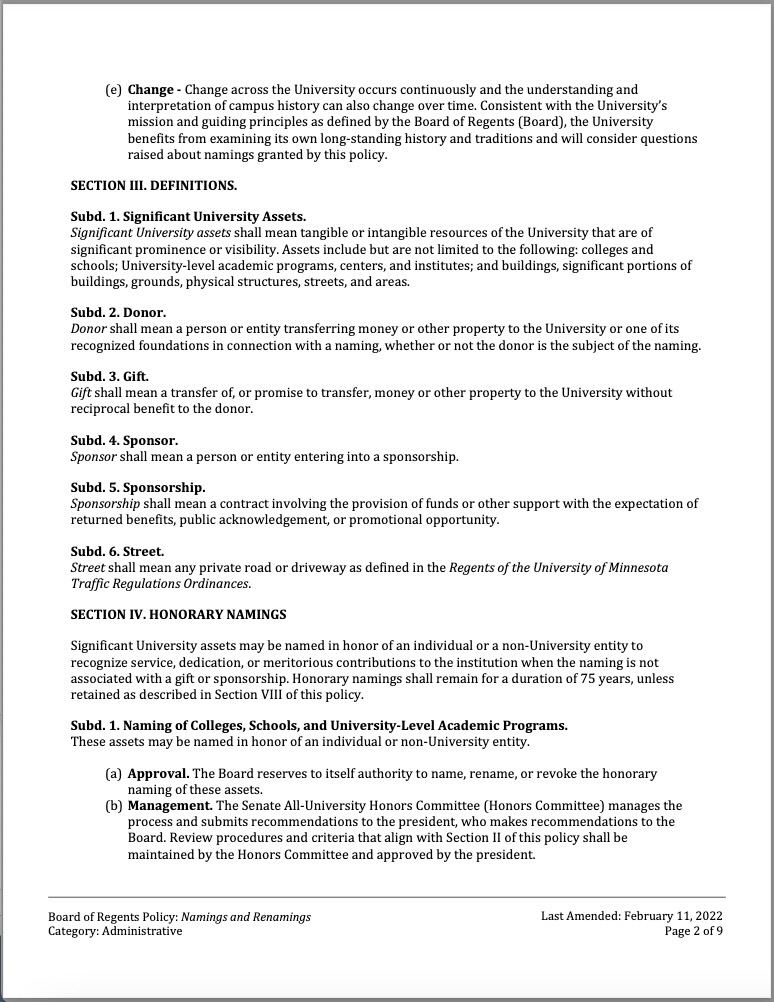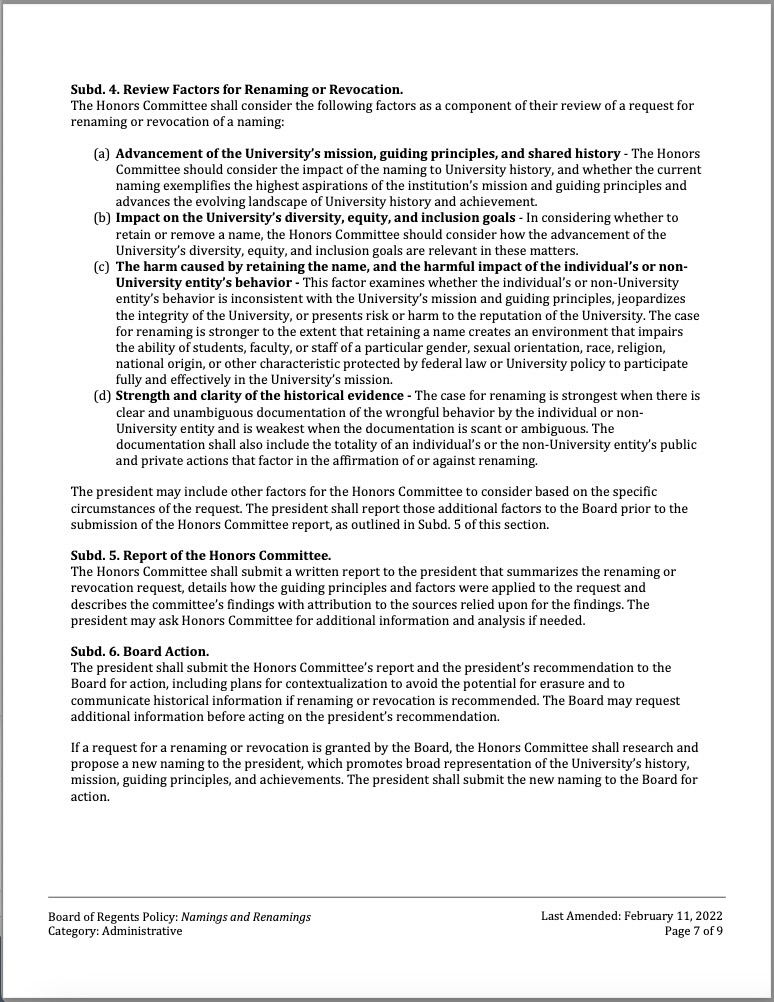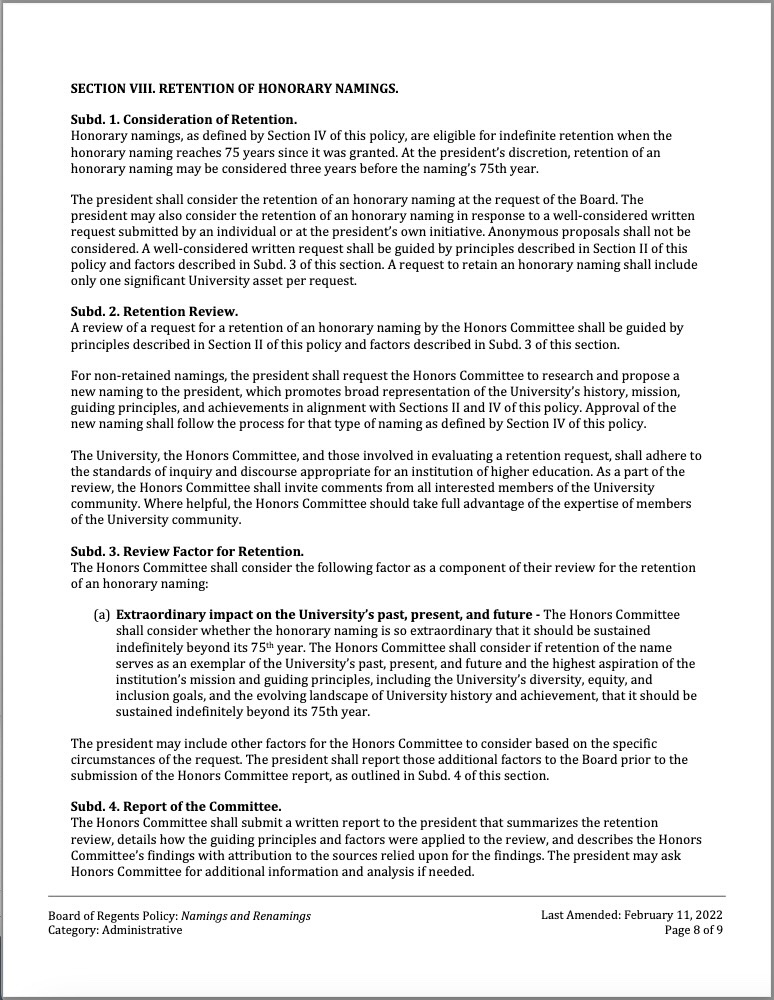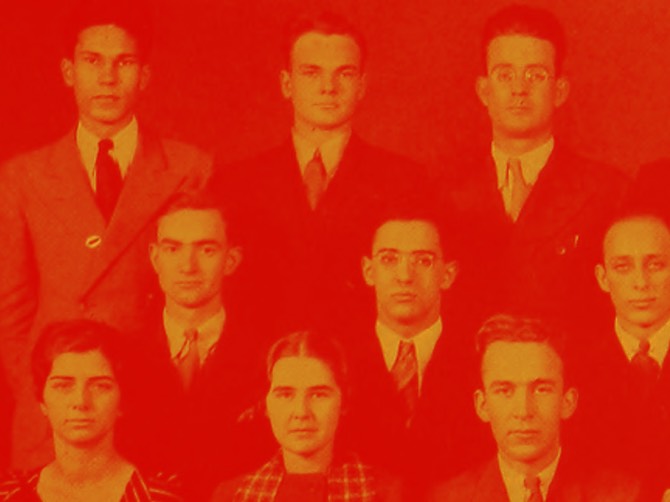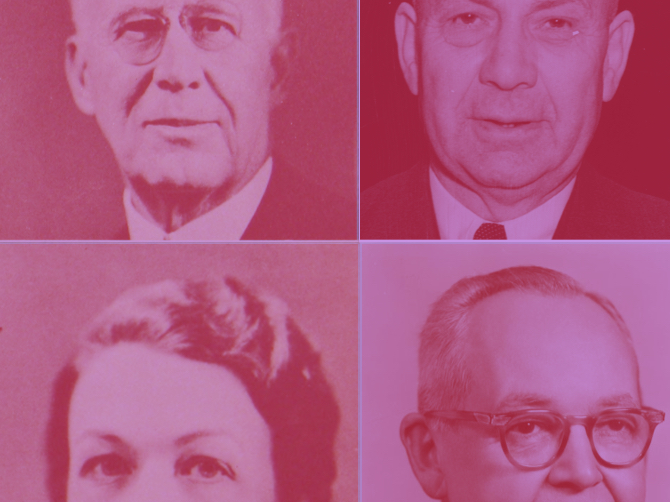Power and Memory: The Movement to Rename Campus Buildings

The exhibition A Campus Divided: Progressives, Anticommunists, Racism and Antisemitism at the University of Minnesota 1930-1942 opened at the University of Minnesota’s Andersen Library on August 14, 2017. A project of the University of Minnesota Libraries, its panels and vitrines occupied two floors of the building that houses many of the University’s archives.
A Campus Divided attracted the greatest number of visitors to an exhibition in the University of Minnesota’s history. People came to learn about this history from on campus and off campus, in groups, classes, and as individuals. Some went on tours led by, among others, the archivist of the Upper Midwest Jewish Archives Kate Dietrick and the curators of the exhibition, Ph.D. candidate Sarah Atwood and Professor Emerita Riv-Ellen Prell. Members of the Board of Regents and senior administrators spent time there as well. No one anticipated that the exhibition would bring to Andersen Library such a large and highly diverse group of visitors.
However, A Campus Divided opened the same week as a deeply disturbing and tragic moment in United States history. The Unite the Right rally took place in Charlottesville, Virginia from August 11-12, 2017. The organizations that participated included the alt-right, neo-Nazis, neo-confederates, neo-fascists, white nationalists, Klansmen, and far-right militias, who were intent on joining forces as a unified political movement committed to an ideology of racism, antisemitism, and anti-Islam. They rallied to protest the removal of a statue of General Robert E. Lee from the city’s Market Street Park (formerly Lee Park). At their evening march on the campus of the University of Virginia members of these groups screamed slogans like “Jews will not replace us,” carrying torches emulating Nazi Germany rallies of the 1930s. Their clothing, insignia, and objects all hearkened back to Nazi Germany and the Ku Klux Klan. The march and the death of a woman peacefully protesting received news coverage across the United States and the world.
When President Donald Trump stated in response to reporters’ questions at a press conference “You also had people that were very fine people on both sides,” his equation of Nazis and racists with peaceful protestors was shocking to the sensibilities of millions of Americans, including representatives in Congress, members of his own cabinet, and people across the nation and the world. These events put the intersection of naming, memorialization, and politics at the center of the national conversation.https://www.politifact.com/article/2019/apr/26/context-trumps-very-fine-people-both-sides-remarks/ Politifact included a transcript of the press conference.
The University of Minnesota exhibition opened in this context with a formal panel discussion at Andersen Library to a standing-room only audience on September 13, 2017. Those who could not get into the room stood in the lobby or toured the exhibition. The event featured Provost and Executive Vice President Karen Hanson, co-curators Atwood and Prell, and John Wright, Professor of African and African American Studies and English. President Eric Kaler was out of the city, but Provost Hanson read a letter from him in which he announced the formation of an advisory committee which “will guide our thinking about the appropriate modern response to historical issues on our campus.” The exhibition was covered in the press, including, notably, in the Star Tribune, which ran a feature about it.https://www.startribune.com/university-of-minnesota-to-probe-its-history-of-racism-and-anti-semitism/444462123/ Sharyn Jackson, “University of Minnesota to Probe its History of Racism and Antisemitism,” Star Tribune, September 14, 2017.
Visitors to the exhibition for the next four months were invited to leave comments on Post-It notes near the final panels. When the colorful notes cascaded over and overflowed beyond the designated spaces, visitors attached their comments to adjacent walls until every space was full. All comments were archived by Kate Dietrick. Most expressed surprise about the University of Minnesota’s history and demanded the renaming of buildings named for the administrators whose policies created and perpetuated racism, antisemitism, and political surveillance.
Immediate Responses to the Exhibition by Students and the Appointment of the Coleman Committee
President Kaler and Provost Hanson announced the appointment of the “President’s and Provost’s Advisory Committee on University History” on October 12, 2017, to be chaired by John Coleman, then Dean of the College of Liberal Arts. It was known as The Coleman Committee, and was made up of faculty, students, administrators, and staff from the Crookston, Duluth, Morris, Rochester, and Twin Cities’ campuses, as well as alumni and donors from beyond the campus. They presented their final report on May 9, 2018, which called for the creation of a permanent advisory committee on University history. Their report, Final Report of the President’s and Provost’s Advisory Committee on University History: Guiding Principles and Recommendations for the Naming Process of Buildings and Other Significant University Assets, advised the Board of Regents to revise its naming policy. That report may be found here.https://conservancy.umn.edu/handle/11299/200473
The student government, the Minnesota Student Association (MSA), became the center of student activism inspired by the exhibition’s revelations, particularly about President Lotus Coffman and other administrators enforcing racial segregation in taxpayer-funded student housing, as well as antisemitism. Coffman Memorial Union, the Minneapolis campus student union building, was the hub of student activities. Eight multicultural organizations were housed on the second floor of the Union, as were the offices of the MSA. Students noted repeatedly that they had never given thought to whom the Union building was named for. What had simply been a name became a person who acted in the 1930s to create racist policies. Shanta Pai, a senior at the time and Chairwoman of the Student Senate, told a Star Tribune reporter, “It was really surprising to see someone whose name we know as a place of socialization [and] getting lunch to be someone who kept students out of University of Minnesota [housing] because of the color of their skin.”Star Tribune, September 12, 2017.
By the end of September, Trish Palermo, Student Body President, called for the removal of Coffman’s name, declaring on her Facebook page, “I ask you all to join me in becoming more informed and acknowledging the blatant irony of housing the cultural student groups in a building named after the man who did everything in his power to keep the University segregated. I fully support the ask to rename Coffman.”
The MSA drafted a three-page resolution on December 1, 2017, calling for Lotus Coffman’s name to be removed from Coffman Union. It noted the work being done by the 2016-2017 Campus Climate Group that established the Bias Response and Referral Network in order “to respond to discrimination and affirm the University’s commitment to equity, diversity, free speech, and academic freedom.” It included a description of 76 reports of bias on the campus for the year, which involved racism, antisemitism, and other forms of religious discrimination.
The resolution noted that “[t]he persistence of Coffman’s name not only makes the University of Minnesota’s student union less welcoming, but it also directly contradicts the ‘We All Belong Here’ campaign, as former President Coffman actively divided students and explicitly stated that not all types of students belong at the institution.” In addition, the student resolution asked, among other requests, that a committee be established consisting of students, faculty, and staff to select a new name and that a plaque be placed inside the Union that detailed Coffman’s full history, including his contributions and legacy. The resolution was supported by more than twenty student groups and sixteen faculty members.
Student leaders remained active in building support to change the names of campus buildings
On February 11, 2018, Chloe Williams, a senior and head of the Minnesota Student Association Inclusion and Diversity Committee, initiated a petition titled Rename Coffman Memorial Union, which was addressed to President Eric Kaler and the Board of Regents. The petition closed with 4,995 signatures.
On March 6, 2018, the Minnesota Student Association Forum Body met in Fraser Hall and unanimously passed the resolution to rename Coffman Union as “Memorial Union.” Emma Dunn, MSA representative from Minnesota Hillel, described the new name as “neutral,” while memorializing students who were discriminated against in the past.https://mndaily.com/225636/news/acmemorial/ Max Chao, “UMN Government Votes to Rename Coffman as Memorial Union,” Star Tribune, March 8, 2018.
That previous day, Minnesota Daily journalist Ellen Alits editorialized about the importance of the vote that would take place that afternoon. She wrote,
Those against such “name-change advocacy” might argue for the preservation of history, but in considering this point, we should ask whose history we are preserving, and why. A person being memorialized means just that — they are someone who is worthy of being remembered. Coffman is just one example of all the racist memorials across our country that are preserving a history of white supremacy. We can, and should, preserve Coffman’s memory by discussing him and his legacy elsewhere; attempting to whitewash the past isn’t the point here. Renaming Coffman is simply a refusal to honor the man’s memory by memorializing him on one of the most-used buildings on campus, one that houses various cultural groups and MSA itself. Coffman’s legacy requires proper contextualization, which is impossible to do when the building simply bears his name. Remember Coffman and other bigoted administrators through exhibits, informative plaques — not through giving them the anonymity and omniscience of a building name.Ellen Alits “Rename Coffman Union to Support an Inclusive and Progressive Campus Culture,” Minnesota Daily, March 5, 2018.
The Minnesota Student Association leaders continued to press to remove building names with an April 25, 2018 “Silent March,” to demonstrate that they were silenced by the presence of “racist and antisemitic administrators’ names remaining on buildings.”
The Task Force on Building Names and Institutional History
In response to the 2017 MSA resolution and the report of the May 9, 2018 Coleman Committee, President Eric Kaler and Executive Vice President and Provost Karen Hanson announced the appointment of a Task Force on Building Names and Institutional History on September 13, 2018, to “recommend actions regarding specific buildings” which were proposed by students. The buildings included Coffey and Nicholson Halls, Middlebrook Dorm, and Coffman Memorial Union. The committee was to gather feedback, which was accomplished through a public web forum and email. They received about 275 responses.
The task force was to make its recommendations to President Kaler, who would then communicate his view to the Board of Regents, the final authority on all issues related to naming any “asset” on the campuses of the University of Minnesota. The Regents Policy on Namings, including the “revocation of names,” provided some guidance to the task force. The members of the task force primarily drew on the Board of Regents Code of Conduct to guide their deliberations, as well as the core university values articulated by the Coleman Committee. Their final report may be found here: https://conservancy.umn.edu/handle/11299/202590
In contrast to the large Coleman committee, President Kaler appointed a small committee to serve as an intensive working group to produce recommendations on the building names. The committee, which met ten times, consisted of nine faculty members with expertise in history (including American legal history), public space, memorialization, and American Indian, African American, Asian American, and Jewish Studies. One undergraduate and one graduate student were also appointed. It was co-chaired by Dean of the College of Liberal Arts John Coleman and Professor Susanna L. Blumenthal, the William Prosser Professor of Law and Professor of History.
The February 25, 2019, Report of the Task Force on Building Names and Institutional History investigated and weighed the contributions of each of the four administrators individually. It also detailed the effect of their actions on the lives of Black students throughout the 1930s, particularly about segregated housing. In addition, the report examined Dean Edward Nicholson’s program of surveillance on students, and repression of student rights to gather, distribute information openly, and to protest. The report included extensive research in the University of Minnesota archives, the Minnesota Historical Society archives, and reviewed the Minnesota Daily and the Spokesman, a Minneapolis African American newspaper.
The task force produced a 125-page document based on their archival research, in addition to the research conducted for A Campus Divided, examining the careers of each of the administrators for whom each building was named. They also drew on secondary literature about the period. Their report relied on scholarship concerned with memory, remembrance, and the politics of naming, which was ubiquitous at the time.Debates over changing the name of a prominent Minneapolis lake to its original Dakota name unfolded before and during this debate. At the same time, efforts to use the Dakota name alongside the English name of Fort Snelling resulted in a threat by Republican lawmakers to remove all funding from the Minnesota Historical Society, which oversees the site. https://www.minnpost.com/community-voices/2019/05/signs-of-the-times-indigenous-women-and-indigenous-place-names/)
The high standard the task force members set for writing about these four administrators required a great deal of time for faculty, staff, and students who all had full time positions and obligations. Therefore, the task force requested a few extensions, and the report was not finally completed until March. Student activists were frustrated that the buildings continued to carry the names of these men. However, the committee remained committed to producing a serious work of scholarship. The time pressure on task force members, the extensive and detailed research that was required, and the scope of their work created, in retrospect, a nearly impossible assignment that they nevertheless completed.
The report was made public in early March of 2019 and presented to President Kaler and Provost Hanson. The members of the Board of Regents received the report in advance of their March 8, 2019 meeting. Six days prior to the meeting, President Eric Kaler expressed his support for removing all four names from campus buildings. He stated, “I entered this process with an open mind, and at this stage I believe that changing the names is the right path for the University of Minnesota.” Kaler said in an email, “I would like to continue hearing from the University community and engaging with the descendants of the individuals after whom the buildings were named.”Austen Macalus, “Temporary names: Coffman Memorial Union to Student Union, Nicholson Hall to 216 Pillsbury Drive, Middlebrook Hall to West Bank Residence Hall, Coffey Hall to Agricultural Administration Building,” Minnesota Daily, March 1, 2019.
Prior to the meeting, opinion pieces and letters to the editor appeared in the Star Tribune regarding the issues of changing names of public buildings and landmarks on the campus and in the Twin Cities.
The Minnesota Student Association drafted a second proposal to be introduced on February 26, 2019, as the “Minnesota Student Association Statement for Unnaming Coffman Memorial Union, Coffey Hall, Nicholson Hall, and Middlebrook Hall in support of the report of the Task Force on Building Names and Institutional History.” Its authors were Tala Alfoqhaha, Diversity and Inclusion Director, Nikil Badey, Outreach Director, and Natasha Sohni, Ranking At-Large Representative. Its cosponsors were Simra Mishra, MSA President and member of the Diversity and Inclusion Committee, and Jael Kerandi, Ranking Representative to the Board of Regents.
It passed again.
Brief Overview of the Responses to the Task Force Report
A debate raged from March 8, 2019—the first meeting of the Board of Regents to consider the recommendations of President Kaler to remove the names of administrators from four Twin Cities campus buildings—to the Board’s final vote at a special meeting of the group on April 26. The debate over the report generated heated conversations, including, in some cases, disturbing accusations, and often frustration not only in every constituency of the University of Minnesota, but across the Twin Cities as well. This firestorm was precipitated by an attack on the report by three regents and in particular, accusations by two of them against the task force members. These regents raised questions about the accuracy of some statements and interpretations in the report, questioned their “bias,” and impugned the integrity of faculty members; one called for “investigations” of faculty, which never happened.
In the intervening month between the meetings, the Star Tribune and Minnesota Daily covered the events and issues regularly. On campus, students, faculty, and administrators addressed the question of un-naming buildings in panel discussions, meetings, teach-ins, editorials, and newspaper letters to the editor. University and student groups passed resolutions, and President Kaler wrote a university-wide message suggesting that debate was appropriate but attacks on faculty were not. At least two regents continued their accusations against the task force members publicly in a variety of venues and never engaged in open debate with scholars to discuss them.
The recommendations regarding un-naming buildings were, to no one’s surprise after a month of explosive conflict, rejected by members of the board 10-1. At the same time, by a vote of 9-3 and then 11-0 the regents passed resolutions commending the faculty and committing the university to further explorations of the history of the University of Minnesota. One regent publicly and forcefully repudiated the two regents whose attacks on the faculty he viewed as unacceptable. Nevertheless, the resolution stated that history was never fully “knowable” and rejected assigning personal responsibility to any past administrators for the history of racism and antisemitism, speculating instead about what they called governance—who had the real power to create these conditions? During their discussions, the regents gave no scholars an opportunity to fully address the role of previous regents, turning instead to their own unsupported and undocumented speculations.
The Board of Regents Meeting on March 8, 2019 to Discuss the Task Force Report
All meetings of the Board of Regents are open to the public except for ones where business related to personnel and situations where attorney-client privilege operated. They are also available to be viewed in real time and subsequently on the Board of Regents YouTube channel.
The written minutes of Board of Regents (pp 173-174 docket items for discussion) offer only a brief sketch of who was present and spoke and the outcomes of agenda items.
The Board of Regents sets its agenda and invites University administrators, faculty, staff, students, and other professionals to address them on specific issues. Only regents are allowed to speak without a formal invitation. The people who were allowed to speak about the task force report at the meeting were first, the president and provost, and then the two co-chairs of the task force, Dean Coleman and Professor Blumenthal.
The meeting was expected to be intense given that the question of removing names from any university or public space was viewed as highly controversial. Chair of the Regents David McMillan established ground rules for the regents’ discussion and questions. He repeatedly emphasized that they had a limited amount of time available to discuss the report because of the pressing business of another agenda item. He explained that there would be other opportunities for discussion, though he stated he was unsure when, and that the vote would not be taken until May or June.
He laid out framing issues and suggested that there would be further questions about how overall “governance” issues at the University affected (though he did not use these words) segregated student housing. He emphasized that families of the administrators would be contacted and the regents were in communication with some of them.
It was clear that regents had sent questions to the task force members for clarification, and though some were answered, and errors or typos were corrected by the time of the meeting, they were again mentioned by one regent.
Viewing the meeting video reveals an atmosphere that was far more than heated or even contested. What began as a cordial meeting with expressions of appreciation to the task force members and for the work of the task force by Chair of the Board of Regents McMillan, President Kaler, Provost Hanson, and a few regents gave way to acrimonious accusations. The task force co-chairs carefully laid out their assumptions; the Board of Regents’ policies from which they drew for their conclusions; the charge to them from a previous committee, the president, and the provost; and discussions of their considered approach to addressing the complexity of history. None of these issues were discussed. Rather, two of the regents—Michael Hsu and Darren Rosha—monopolized much of the meeting with a series of accusations against the members of the task force. Within a short time, one regent stated, “we should have other people do this work” in reference to research on University history.
The few regents who spoke raised questions about University “governance” and administrators’ accountability. They argued that it was illegitimate to judge these administrators’ actions by “current norms,” that it was unfair to scrutinize the records of people who were long-dead, and that racial segregation was really the responsibility of other authorities. They demanded that the University of Minnesota be held only to the norms of life in Minneapolis, which was then dominated by racism and antisemitism. These regents turned on task force members, attacking their motivations, integrity, and honesty, while accusing them of “trying” administrators who could not defend themselves. The two regents, paradoxically, created their own courtroom, shocking everyone at the meeting. No statement was quoted more following the meeting than Regent Rosha’s. pronouncement:
And when I heard about this, I was expecting white-hooded, brown-shirt-wearing racists spewing all this vitriol against these people and quite frankly I saw administrators struggling with what appears to be a board that was holding older positions.
The statement drew attention not only because it diminished the experience of students who faced constant discrimination, but because, as several groups noted, it defined discrimination only in narrow terms. The regent explained his position at the April meeting.
Only Regent Abdul Omari praised the report as “thorough and fair,” and stated that “what I have read and seen is overt racism. I don’t see a context or a time in which that is OK.“ He argued that un-naming buildings is not about “rewriting the past, but about recognizing and owning it so that in one hundred years people will see that we tried to do something.” He also criticized the attacks on the faculty members of the task force.
Few other regents ever spoke as the chair explained the meeting needed to end because of their other business.
The Escalating Fight Over Renaming: University Conversations and Regent Attacks
The month between the two regents’ meetings about the issue of un-naming four campus buildings was a period of countless meetings and conversations among the many constituents of the university. This account is limited to public, on the record events and media coverage. Private meetings held by regents with one another and other stakeholders were not public, nor were communications they received. Activities during the month occurred on and off campus, in the media, in private meetings, and in an aggressive campaign by regents Michael Hsu and Darren Rosha to persuade students and others of their positions. Star Tribune journalist Mila Koumpilova called it “a war of words.”Mila Koumpilova, “At the University of Minnesota, a war of words erupts over building Names,” Star Tribune, March 19, 2019. https://www.startribune.com/at-the-university-of-minnesota-a-war-of-words-erupts-over-building-names/507328642/
President Kaler and Provost Hanson sent a university-wide email calling for open conversation, but greater respect in discussions and respect for the task force. Many perceived this statement as “too little; too late.” These leaders had said nothing about the conduct of the most aggressive regents, nor had other regents. The email was intended to change the tone of the discussion.
At the same time, the University administrators and regents invited and met with the descendants of some of the four administrators named on the buildings. They issued no invitations to any family member of former students directly affected and harmed by the actions taken by these administrators. No one explained why. At the April 27 meeting, Regent Omari stated that he declined to meet with the descendants of Vice President Middlebrook because no family members of those harmed by the University were invited to comparable meetings.
At no point did any regent engage in a conversation with the scholars the Board had accused of misrepresenting the historical record. The regents never allowed others to question them directly about their personal theories about power and authority at the University of Minnesota in the 1930s. They never allowed any questions about documents they claimed “proved” their interpretation of who was responsible for segregated student housing then. They never produced or distributed these documents. They never engaged in any conversation about the history of the period or how to interpret the contexts of racism and antisemitism in the 1930s.
Campus Activism and the “War of Words”
The Regents’ firestorm also led to energetic on-campus discussions, protests, and the sudden appearance of a material culture calling for renaming of buildings. Editorials appeared in the press on and off campus. Many faculty and students on the campus became engaged by issues not only of racism and antisemitism in the 1930s, but how those issues were experienced by students in the present. They also reacted to the behavior of some regents and their accusations leveled at faculty members of the task force, some of whom were affiliated with African and African American Studies, American Indian Studies, Asian American Studies, and Jewish Studies.
The Minnesota Student Association that led the campaign to remove Lotus Coffman’s name from the Union building widely circulated a response to the regents in which they challenged, one by one, the accusations of the three most vocal regents at the March meeting. They were especially motivated by their frustration with Regent Rosha’s claim that “I have so much respect for the students, and I’m so frustrated for them because when I read their resolutions, it is based on faulty claims.” The MSA rejected this statement, as it did other statements by Regents Beeson, Hsu and Rosha, to which they responded in detail.
Stickers with images of Coffman Union reading “Rename the Racists” and “White Pillars, White Supremacy” appeared overnight all over the Minneapolis campus. It was unclear who created and distributed them. Flyers appeared as well.
Members of the faculty also organized events where they analyzed both the issues raised in the task force report and how Regents Hsu and Rosha spoke about it. The first took place at the Humphrey School of Public Affairs on March 26, 2019. The participants in the panel included faculty members Professors Samuel L. Myers Jr., Joe Soss, and Ryan Allen, among others. Dean Laura Bloomberg presided over the forum. The participation of senior faculty and the dean and the presence of many fellows and students underlined the significance of issues of racism and inequality to their work.
Faculty members and students organized a “teach-in” on “Who Erases Whom: Ongoing Injustices, Building Names, and Institutional History” on the Minneapolis campus on April 17, 2019 in Walter Library. It was a project of the Race, Indigeneity, Gender and Sexuality Studies Initiative (RIGS). The teach-in was an alternative type of education developed during the war in Viet Nam when faculty and students gathered to learn, discuss, and commit to action about important political issues of the time.Teach-ins often were held when students and faculty went on strike to protest the war. Presented as a parallel to a sit-in, an important political technique used in the Civil Rights Movement, they offered a contrast to a classroom where the distance between faculty and students or a focus on a specific subject would be upended. The multiple sessions of the April teach-in encouraged students to come to a session, stay for all of them, ask questions, and discuss their own experiences. Faculty members offered a session and often stayed for the others. Many members of the task force taught at the teach-in, providing historical contexts not only for the racism and antisemitism on the campus in the 1930s, but also for the regents’ present statements. https://en.wikipedia.org/wiki/Teach-in
The formal university governance system responded to the regents’ first meeting about the task force report and the faculty and student members who served on it. Two committees of the University Senate—the Social Concerns Committee (SCC) and the Equity, Access and Diversity Committee—co-authored a statement reprimanding the regents. Because some of the regents framed task force members as “politically motivated,” members of these committees argued that the result was to “chill discussion required to resolve the building name dispute.” The committee chairs Ingrid Nuttall (Social Concerns) and Professor Keisha Varma (Equity, Access, and Diversity) informed the joint meeting of the University Senate and Faculty Senate on April 4, 2019 of their statement, which was sent to the regents.
Board of Regents policy states that the University must create an environment of respect and integrity that fosters the open exchange of ideas. SCC Chair Ingrid Nuttall said the regents did the opposite. “It’d be difficult to watch that regents meeting and feel there was a dialogue,” Nuttall said. “The spirit of those conversations needs to be in good faith.”Jake Steinberg, “Regents Reaction to Naming Violated its own Principles, Committee Says,” Minnesota Daily, March 27, 2019. https://mndaily.com/246172/news/adregentsreaction/
The Faculty Consultative Committee (FCC) represents the faculty at large, rather than any specific unit. It serves as a consulting body to the university president and as the executive committee of the faculty senate. Its chair makes regular reports at the meetings of the Board of Regents. Amy Pittenger, then chair of the FCC, wrote to the regents following the March meeting. The FCC urged the regents to meet with the authors of the task force report in a neutral environment. The regents were also reminded that the university was a community, and accusations by some of the regents undermined the fact that the university has a shared mission.Mila Koumpilova, “At the University of Minnesota, a War of Words Erupts over Building Names,” March 19, 2019. https://www.startribune.com/at-the-university-of-minnesota-a-war-of-words-erupts-over-building-names/507328642/ Jake Steinberg, “Regents Reaction to Renaming Violated its own Principles, Committees Say,” March 27, 2019. https://mndaily.com/246172/news/adregentsreaction/
The Star Tribune reported that Board of Regents Chair David McMillan apologized to Dean Coleman and Professor Blumenthal, the task force co-chairs, and stated that he found the board discussion “surprising and disappointing.”
Mila Koumpilova, who reported for the Star Tribune on the debates over the task force report, the actions of members of the board of regents, and other campus responses, continued to interview regents Michael Hsu and Darren Rosha. She documented their statements and accusations. Hsu, with no proof, claimed that task force members should be “investigated” for “intentionally” leaving out evidence “in making a case that the late administrators backed campus housing segregation and other racist practices in the 1930s and ’40s.” Hsu found no support from other regents for an investigation.Mila Koumpilova, “At the University of Minnesota, a war of words erupts over building Names” March 19, 2019. https://www.startribune.com/at-the-university-of-minnesota-a-war-of-words-erupts-over-building-names/507328642/
The campus discussions and debates often responded to what some regents were calling “facts” and “evidence.” The role of the Board of Regents in voting to support President Coffman’s rejection of student demands to integrate Pioneer Hall in 1935, for example, was offered as a “fact” that exonerated Coffman. Dean Edward Nicholson’s spying on students he identified as “Communists” was dismissed as having no relationship to antisemitism (both these issues are discussed in the essays “Segregated Housing and the Students who Defeated it” and “Political Surveillance at the University”). At no point did a regent comment on the appropriateness of Dean Nicholson surveilling students and faculty or working with the FBI, simply that he was not antisemitic. Regent Michael Hsu claimed to have examined thousands of pages in the archival collection of long-time Chair of the Board of Regents Fred Snyder. However, he never put in writing what he found or opened his observations to discussion with scholars.
Hsu and Rosha sought to take students to the archives to “prove” their knowledge of “facts” overlooked by the members of the task force. One student was James Farnsworth, who, Rosha explained at the April Board of Regents meeting, was the only one who went to the Minnesota Historical Society with him to look at documents. Farnsworth concluded that nothing he was shown changed his mind. He said, “For me, I understand why the archives are being looked at. I certainly respect the regents right to take this governance question as they please. But if I was a regent, I would really be focusing on process and conversations about how to move forward.”
The Minnesota Daily also contacted and interviewed some of the nation’s most important scholars of racism and antisemitism in higher education during the 1930s. Historians on the faculty at New York University, the University of Wisconsin, and the University of Michigan were asked about regents’ claims about “documents.” Each of them stated independently that no historical research is done by simply reading documents outside of understanding historical contexts, and without interpreting documents through other sources. They were unconvinced by the claims that regents made about President Coffman and Dean Nicholson.
The Regents Defeat Un-naming: Professor John Wright Changes the Narrative
The University announced a Board of Regents “special meeting” to be held on April 26, 2019, where the vote on un-naming buildings would be taken. The fact that a “no vote” on the resolution was a foregone conclusion dissuaded no students, faculty members, or staff from attending the meeting. To the contrary, people came by the dozens. A crowd overflowed the meeting to gather in the long hallway outside of the Regents’ boardroom. Students smuggled in placards, forbidden by the regents, to protest maintaining the building names. Though campus security seized most of the placards, students still found ways to bring several inside the boardroom.Niamh Coomey, “Students Respond to Regents Vote to Keep Building Names,” Minnesota Daily, April 26, 2019. https://mndaily.com/260058/news/acstudentresponse/
In keeping with Board rules, the attendees inside the boardroom were denied the right to participate and were constantly referred to as an “audience” by the regents. Many refused to remain silent. They verbally reacted, jeered, challenged, on occasion laughed, and protested by whatever means were available to them to what was said by some of the regents. Despite the gag order imposed on all “observers,” they became unauthorized participants.
Only in the last minutes of the regents’ meeting did anyone explain why a special meeting had been called, and why a vote was being taken on the motion to reject removing names from campus buildings. That vote was originally scheduled for either May or June. President Kaler was called upon by the board’s chair pro tempore, Regent Thomas Anderson, to explain when the question was raised by Regent Michael Hsu. Kaler said,
The feeling was the community is roiling a bit, more than a bit, and divisive and hard things have been said, and people’s reputations have been attacked. The chair and vice chair [of the Board of Regents] and I agreed to address issues around the faculty’s integrity and academic skills while continuing the dialogue around our history… It is time to attempt to bring some closure to the debate and do it sooner rather than later.
It became apparent that virtually the entire board of regents’ special meeting was engineered by a small number of regents in consultation with President Kaler to respond to the attacks on the faculty and the task force at the March meeting. Three resolutions were presented, discussed, and voted on at the meeting. Some regents revealed that the resolutions had been drafted without consultation with them and their feedback offered earlier in the week when they were finally consulted was rejected. Each resolution was carefully written to commend the faculty and the work of the task force and emphasized the close relationships between regents and faculty. The University’s history of antisemitism and racism was acknowledged, but in contrast to the task force report, never described with any specifics. The board’s refusal to remove any names from buildings, assumed long before the vote, was also cast as in no way a rejection of the University’s responsibility for a history of racism and antisemitism or an indictment of the task force. Despite these efforts to distance most regents from the actions of Regents Rosha and Hsu, these two men continued to question and attack the report. Regent Beeson raised many questions and made far reaching assertions about “governance,” despite taking a more measured tone.
Brief Overview
The meeting proceeded from the introduction of three resolutions, to discussion of the first one that raised the same questions and attacks leveled during the March meeting, to the second resolution, and the approval of the final resolution. Prior to the approval of the second resolution, President Kaler and Professor Amy Pittenger, Chair of the Faculty Consultative Committee, called on the Board of Regents to be respectful to faculty and to continue conversations on these topics. Before the second vote, a dramatic turn of events followed their remarks when many attendees spontaneously protested, loudly demanded to be heard, and called for the regents to be addressed by Professor John Wright, who was also in the boardroom. After his remarks, the second and third resolutions were passed.
The First Resolution on Building Names: Commending the Faculty while Rejecting their Task Force Recommendations
Regent Steve Sviggum, a former Republican Member and Speaker of the Minnesota Legislature who served from 1978-2007, noted at the outset that the resolution before the board offered no statement of resolution, which defeated the purpose of proposing a resolution. Nevertheless, the regents were called upon to accept it.
What did the 3-page single spaced resolution do?
It appeared to have five purposes:
- It rejected both the task force report’s call to remove building names and President Kaler’s support for that action.
- It repudiated the attack on the report and the faculty who wrote it at the March meeting by Regents Hsu and Rosha, though it did not name them in writing. Words like integrity, commendation, and respect for the task force report adorned the resolution.
- It called for “atonement” for past discriminatory practices, offering minimal statements about the nature of that “discrimination” beyond “racial and religious division.”
- It offered a maze-like path to address these issues if removing building names was unwarranted. Regents resolved to broaden their inquiry and to include “social, legal, and governance contexts.” Yet, research could not, the resolution stated, address the fact that the “lens of history” leaves issues “unresolvable in hindsight.”
- It called for more debate, more discussion, educational displays in the buildings named for administrators whose personal responsibility was dismissed, and study of practices that violated the “values we hold dear.”
An effort to amend the resolution by those regents who felt excluded from the process of drafting it was defeated by a vote of 7-4.
The debate on the resolution reiterated the issues from the March meeting. The regents whose behavior the resolution repudiated continued to assert the same arguments: the task force report left out information, failed to pay attention to the actions and power of regents Fred Snyder and William Mayo, and other “governance” issues. One regent called for “third parties” to conduct the research, echoing previous attacks on the faculty members of the task force committee.Following the meeting, Star Tribune reporter Mila Koumpilova published her findings after reviewing all the emails of task force members and other administrators related to the report. She found no evidence of “twisted information” or “intentionally exclude(ing)” information to malign Coffman or others. She found examples of rushing to complete their work, searching for documents with too little time, and frustration with university administrators. Mila Koumpilova, “Documents Reveal More University of Minnesota’s Rushed Effort to Rename Building,” Star Tribune, June 8, 2019.
The resolution passed on a vote of 8-3. One regent called for a voice vote to make certain that how people voted would be made public.
Statements Prior to the Second Resolution Vote to Reject the Recommendation to Un-name Buildings
The regents were then addressed by Professor Amy Pitte
nger, whose role as chair of the Faculty Consultative Committee made her a spokesperson for faculty governance. She too called for respect for the faculty and for faculty and regents to cooperate. Like the resolution, she called for more discussion, and specifically sought an “open forum” where “historical scholars” could address their methodology in the research.
She was followed by President Kaler, who expressed his regret that he had hurried the process.
Rather than taking a vote on the motion to reject un-naming four buildings, the meeting took remarkable turns that continued to undermine the aspirations of the leadership to praise the faculty, contain some regents, and end the controversies around the task force report.
Regent Richard Beeson read a prepared statement, which he explained he was doing for the sake of “posterity,” since these issues would be revisited by future regents. He noted that his comments were focused on President Lotus Coffman as “the central figure” and the importance of “words and sentences.” He condemned the university’s sanitized history of the 1930s.
His statement addressed in various forms issues that were repeatedly termed “context” and “governance.” He described, for example, a letter from a regent to then Dean Walter Coffey about race. He noted the “tremendous power” of two long standing regents, William Mayo and Fred Snyder. He offered speculation about, for example, why President Ford supported integrated student housing, claiming falsely that President Ford was only an “interim” president and that might explain his stance. He suggested without proof that Ford was unaware of the Board of Regents stance on segregated housing.
Beeson then switched from speculative claims about governance to his view of “context.” As he had at the previous meeting, he reiterated the extent of racism and antisemitism in Minnesota. Beeson asked rhetorically, “Was the University more tolerant than the state that it served?” He replied, “Yes.” He asked, “Was there evidence of other discrimination on campus [other than housing]?” He replied definitively, “No.”
The Audience Revolts
Regent Beeson’s resounding “No” to the existence of discrimination (other than in housing) in the 1930s was the match that lit the tinder of students, staff, and faculty frustrations with false statements, attacks on them and those they admired, and the denial of the revelations about racism and antisemitism. Indeed, Beeson brought down a firestorm of words that overtook his:
A student shouted, “Just hold a minute, Regent Beeson.”
Another followed, “This is amateur scholarship. This was your chance to get scholarship right; look how you act!”
Another added, “We ask for respect from the board.”
Those seated in the back of the boardroom continued to protest volubly as the chair gaveled repeatedly, demanding order.
Riv-Ellen Prell, Professor Emerita and Co-curator of A Campus Divided, called out, “Let John Wright speak. His family was on campus under Coffman.”
Beeson persisted in reading his remarks over the protests of a group that had transformed from “audience” to protestors. Chair Pro Tem Regent Dean Johnson gaveled for silence and Prell continued to ask to let John Wright speak, a call taken up by the rows of participants. The chair warned the group, “You have two minutes to respect the board and then you will be removed by law enforcement.” He then called for a five-minute break.
No one backed down. A student commented forcefully, “It’s curious that you mention inequality in this board room and you will not let us speak. Just saying it is not enough!” She was followed by Regents Professor Elaine Tyler May who asked loudly, “Why is there no comment from the faculty members and students at this meeting who can answer every misstatement made that is untrue?”
Amidst demands for order, and the insistence of the university community in the room to be heard, Professor John Wright walked slowly and deliberately from his seat to face the horseshoe shaped table where members of the Board of Regents sat. He said nothing; he simply faced them.
“You have one minute more,” Johnson warned, continuing his threat to call “law enforcement,” and arrest whom, it was unclear: Professor Wright? every member of the task force seated in the audience? all the student leaders, senior administrators, committed staff members, faculty? A shout went up from the group, “surround John Wright; protect John.” Within seconds, many of those seated in the back stood next to him and behind him.
Regent Abdul Omari was about to make a motion to allow Professor Wright to speak after the recess when the Chair Pro Tem stopped threatening people with arrest and offered, “Two of you may speak for no more than five minutes each to tell your story where you see the errors.” Group members immediately stated that only John Wright would speak. He accepted the “invitation,” as he said, “gladly.”
Professor Wright, a fourth generation Minneapolis African American, was retiring from the University in a matter of days. Both his undergraduate and PhD degrees were from the University. He was a professor of African and African American studies as well as English and was regarded as one of the University’s most gifted teachers and important scholars. As an undergraduate, he was active in Black student life and along with other activists had occupied Morrill Hall, the main administration building, in 1969 and authored the demands of the students that led to the founding of African American Studies and other initiatives. Professor Wright was a key advisor to the exhibition A Campus Divided and served on the Coleman committee, having declined to join the task force. More than any voice, he continued to call for addressing issues that went well “beyond naming.” He argued for using resources to expand the faculty in African and African American studies.
“No One Has A Permanent Lease on Honor:” John Wright Retold the History of African Americans at the University of Minnesota
Professor Wright, in his impromptu address, with no anticipation of the opportunity to address the regents, told the story of his own family’s three-generation experience at the University of Minnesota, with ties that stretched back to 1901 and during what he called “the Coffman era.” Wright recounted previous efforts with which he was involved to document a full history of African Americans at the University of Minnesota and their contributions. The genesis of what became a three-part series in the Minnesota Alumni Magazine in 2002 was led by the Reunion Committee of the 1969 Morrill Hall Takeover that demanded the creation of an African American Studies department and hiring faculty and support for African American students, among other issues. He noted that the Campus Divided exhibition appeared in the broader context of American higher education confronting its roots in slavey. Universities had started to “reassess their institutional histories,” he explained, and pointed out that the University of Minnesota was late to the process.
Wright then turned to the administrators whose “culpability” was under review. To this end he discussed the Twin Cities Black press, beyond the Spokesman, the newspaper most quoted in the exhibition and the task force report. He noted that at the Minnesota Historical Society, the index to the press lists at least 150 items concerning the University of Minnesota. Wright noted that the press frequently focused critically on Lotus Coffman and there was no mention of regents. He reiterated the tremendous importance of the University of Minnesota to African Americans’ aspirations for their children, and the many disappointments with the institution’s treatment of them. Wright continued,
And some of the commentary I’ve seen stemming from the press or comments of regents who acted or otherwise about these things [focused on] the fear of erasing history. The history of Lotus Coffman and Edward Nicholson and Walter Coffey is not going to be erased. That’s not what ultimately is an issue; it’s an issue of honor and institutional integrity, and no one has a permanent lease on honor. Every day we deal, if not just on campus, but in the country at large, with people whose past has come back to haunt them. People who’ve been in positions of honor in public life and higher education and elsewhere, alright, but who, when the truth about the deeds of the past [are revealed], are no longer deserving of [a] place of honor, an enduring place of honor. That’s what the bottom issue is here. This isn’t about naming.
One of the early homilies that I picked up about history is attributed to Mark Twain, and the source remains in dispute and so forth. It was the notion that history may not repeat itself, but it does rhyme. And we may not be repeating history here today. But there certainly are rhymes here from the issues of this institution and its inability to deal with its history from the past, from 80 years ago.
So regardless what the board decides in this regard, I think we’ve accomplished a great deal. Alright. The Campus Divided exhibit did more than we were able to do 15 years earlier [in our efforts to outline] the history of the black press on this campus. And now, the conspiracy of silence that’s kept this institution’s history out of mind and out of the province of our institutional policies and practices; that’s over. These documents are now global property, global intellectual properties, and regardless what this board decides we will continue to wrestle with these things in the future.
Regents, including the Chair Pro Tem who had fifteen minutes earlier threatened to have law enforcement remove John Wright and others, offered resounding applause for his remarks and abundant thanks.
The meeting proceeded to a vote on the resolution. Regents Hsu and Rosha expressed surprise about why the process was ending, why further conversations were not planned. Hsu’s effort to table the motion died for lack of a second and was withdrawn. Their only power seemed to lie in voicing objections to the task force report, and along with Regent Beeson, laying out every avenue to follow to better understand “governance.” Not even Regent Beeson supported their effort.
The regents defeated the motion to rename buildings 10-1, with Regent Omari again supporting the task force, calling out the need for accountability and condemning racism and antisemitism.
The Final Resolution
The regents quickly dispatched their third resolution “Related to Institutional History” (found in minutes above). It resolved in three items to direct the president (who would be the newly appointed Joan Gabel) to work with the regents to create “commemorations, educational activities,” and “permanent educational displays within or nearby one of these buildings to reflect the University’s complex institutional history,” as well as similar commemorations or activities across the system “to promote reflection on the University’s history.” The final item recommended “revisions to the Regents Policy: Namings” to guide future re-naming discussions. The resolution passed unanimously.
The meeting was adjourned after two-and-a-half hours.Star Tribune coverage https://www.startribune.com/university-of-minnesota-regents-vote-to-keep-coffman-union-name-other-campus-building-names/509127872/?refresh=trCoverage; Mila Koumpilova, “U of Minnesota Regents Vote to Keep Coffman Union Name and Other Campus Building Names,” Star Tribune, April 27, 2019.
Students vowed to continue to maintain the campaign to remove names from University buildings in their interviews with the Minnesota Daily.Austen Macalus and Jake Steinberg, “Regents Vote Against Renaming Coffman,” Minnesota Daily, April 26, 2019. https://mndaily.com/213252/news/brfinalrenaming/; Niamh Coomey, “Students Respond to Regents Vote to Keep Building Names,” Minnesota Daily, April 26, 2019. https://mndaily.com/260058/news/acstudentresponse/
Reflections on Twitter by Professor Katharine Gerbner
The Board of Regents special meeting and the revolt of members of the University of Minnesota community who attended it reached the Twitter-sphere thanks to a string of 27 tweets posted by Katharine Gerbner, a historian of religion on the faculty of the University of Minnesota. She framed her description and reflections on what happened at the meeting after she learned the recent “good news” that she had received tenure. The thread was viewed by 628,000 people and retweeted by over a thousand users. Inside Higher Education picked up the story and included some of the tweets. What tenure assured her, Gerbner explained, was the ability to write and speak without fear of retribution and to conduct research on “sensitive topics.” She also wrote as an historian and colleague of many members of the task force. She provided documentation via digital links to videos of the meetings and other information for her followers. Gerbner focused, in part, on the question of who is allowed to speak and who is listened to. In the following sample of her tweets, she makes this point. Note that the numbers refer to the order in which they appear in the thread.Colleen Flaherty, “Tenure, Twitter and Taking Her Board to Task,“ Inside Higher Education, May 14, 2019. https://www.insidehighered.com/news/2019/05/15/historian-u-minnesota-celebrates-tenure-critiques-governing-boards-recent-actions#
19/ Wright made the crucial point that if we want to understand the consequences of racist University practices, we should not look to the University archives, but to the Black press, which carefully documented African Americans’ efforts to gain access to higher education.
20/ This point is essential: we need to ask ourselves WHO WE ARE LISTENING TO and WHAT WE ARE READING in these debates about history & legacy. I believe we need to turn our attention to people like Dr. Wright whose families were directly affected by the legacies of discrimination.
21/ It took protest and possible arrest to force the Regents to give Professor Wright the platform to speak. Once he did, it changed the tenor of the conversation. The Board had already voted against renaming, but I don’t think they would have if Wright had been able to speak earlier.
Professor Gerbner was overly optimistic; in fact, a second vote on un-naming buildings was taken after Professor Wright spoke. It made no difference.
What the Regents Understood About Memory and “Atonement”
The regents’ shared near-unanimous ideas about the history of racism and antisemitism at the University of Minnesota.
- They asserted that history is unknowable.
- They reiterated that it is often impossible to hold an administrator accountable for actions because who had power could not be assessed, and those who acted cannot defend themselves.
- They recoiled at judging others in the past.
- Almost all of them claimed that “contexts,” not individuals, were responsible for university policies, whether that was the politics of the state, or attitudes shared at the time, or the weakness of University of Minnesota administrators.
- Some continued to claim that removing a name would erase culpability, with no explanation of what that meant.
Most regents praised the faculty and their work many times in the meeting and claimed that the rejection of the task force report should imply “no distance with the faculty.” In fact, the task force report addressed every single issue about history, memory, and context, and the values expressed by Minnesota Regents’ policies. Nevertheless, the regents never addressed these issues in their public meetings. As many noted, no historian, no scholar or expert on these issues was ever given an opportunity to address the regents directly, and no regent opened to scrutiny his or her personal theories of governance.
Not until a revolt brought Professor John Wright forward to literally “speak truth to power” was any attempt made to hear the voices of those who were harmed by the University of Minnesota. The tremendous effort by scholars to uncover the voices and experiences of African American students from the 1930s was consistently ignored in public discussion, even if they appeared to affect some regents personally. Many scholars at the University of Minnesota referred to these regents’ meetings as exercises in decrying racism that existed without any discussion of racists, and antisemitism that was pervasive without identifying antisemites. They meant that no one was ever held accountable for the policies that were condemned.
Shortly after the final meeting, Dr. Steven Foldes published an opinion piece in the Star Tribune that evoked George Orwell’s dictum that “who controls the past controls the future, and who controls the present controls the past.” Foldes called attention to the fact that almost all the regents concluded that “no one could be held responsible.”
Who or what then could be remembered, narrated, or recalled to tell the university’s “shameful history?”In October of 2019, student activists Tala Alfoqaha, Nikil Badey, Laura Leppink, Paige Mitchell, and Chloe Williams met and formed the Rename Reclaim Working Group (Rename Reclaim). They began a partnership with the Minnesota Higher Education Worker Center later that year and advocated for a “Public History Project.” https://mnhigheredworkercenter.org/rename-reclaim/ The Towards Recognition and University-Tribal Healing Project (TRUTH) was an initiative that grew out of resolutions written by the Minnesota Indian Affairs Council (MIAC) calling on the University of Minnesota to be “better relatives to the 11 Tribal nations.” TRUTH was a collaborative effort between MIAC and the University. The project is community-led research to tell in their words the history of relations between their Tribal Nation and the University of Minnesota. https://ias.umn.edu/news-stories/truth-project-towards-recognition-and-university-tribal-healing.
The First Phase of Addressing the University’s History
President Eric Kaler stepped down as the University of Minnesota president a few months following the fight over re-naming. He was replaced by Joan Gabel who was the unanimous choice of the regents and the first woman to serve as president of the university. She arrived fully informed about the controversies and she and her staff had viewed the April meeting in real time. President Gabel was raised in Atlanta, Georgia, and most of her previous positions in higher education administration were in the South. She came to Minnesota after serving as Provost of the University of South Carolina. Issues of memory and who is honored were important to her, and she was committed to address them immediately.Personal communication.
The regents affirmed in their resolutions that in the academic year 2019-2020, in consultation with them, the University would develop “ongoing commemorations, educational activities, and/or permanent educational displays, additional markers across the campuses within or nearby one or more of these buildings to reflect the University’s complex institutional history.” No marker or commemoration has appeared to date. Educational activities did take place that year. The arrival of COVID-19 a few short months after the beginning of the academic year 2019-2020 might well have limited what was possible. However, “the development of a revised Board of Regents Policy on Naming Buildings” became central and was passed by the Board of Regents in February 2022, after several years of discussion.
President Gabel announced at the October meeting of the Regents that resources would be available for archives and libraries to facilitate research on the University’s history. She assured the regents that “Today marks a new beginning in our work towards a greater understanding of our complex institutional history.”Mila Koumpilova, “University of Minnesota Leaders Consider How to Tackle Renaming Campus Buildings in the Future,” Star Tribune, October 11, 2019.
The Board of Regents Passed an Amended Policy on Naming: All Minnesotans are Invited to Participate in Naming or Retracting Names for University Buildings Across All Campuses
President Joan Gabel began her conversations about Regents’ naming policies in October 2019, and a final policy was approved in February 2022. The COVID-19 pandemic and George Floyd’s murder, only a few miles from the campus, shaped the months and years of that period. The university suspended many activities in the weeks following the murder because of its immense impact on the entire community. The work on the policy, however, persisted. President Gabel consulted with many constituents in those years. She also provided the regents at their December meeting models of how four other universities handled the issues of naming and un-naming buildings to help frame their discussions.Mila Kumpilova, “University of Minnesota Leaders Discuss How to Rename Buildings in the Future,” Star Tribune, October 11, 2019.
In July 2021, the revision to the regents’ naming policy had begun to take shape with some of its key features articulated at a July meeting. President Gabel and the regents had reached an important consensus that virtually all named buildings on all campuses should come up for review to maintain or remove the names. They were eager to open new opportunities for honoring achievements by selecting new people to honor. Regent Janie Mayeron noted, “Our buildings are basically named after men. White men.” President Gabel initially proposed that a building name would automatically be brought up for review 100 years after it was named, but the regents argued for reviewing building names after 50-75 years.Ryan Faircloth, “University of Minnesota Leaders Renew Discussion over Remaining Campus Buildings,” Star Tribune, July 8, 2021.
Gabrielle Lombard, writing for the Minnesota Daily, laid out the policy that was passed by the Board of Regents in February 2022 and explained that it would fall to the All-University Honors Committee to create an administrative process to realize it. Grace Yang, the Minnesota Student Association representative to the Board of Regents, expressed satisfaction with this step. She noted that the MSA had called for a new policy since 2019. She credited President Gabel’s commitment to the process and changes in the membership of the Board of Regents for its successful completion. Yang saw this new policy as a “step in the right direction” to create “an inclusive university.”Gabrielle Lombard, “UMN Board of Regents lay out policy for renaming campus buildings,” Minnesota Daily, February 26, 2022.
The Regents Pass Proposed Amendments to their Policy: Namings
President Joan Gabel presented to the regents’ Committee on Governance and Policy at their February 2022 meeting a “comprehensive review” of the naming policy. The twenty-five pages of background and revisions that were created by the committee may be found at this link: https://regents.umn.edu/sites/regents.umn.edu/files/2022-02/docket-gov-feb2022-v2.pdf
Every governance group of the University was consulted along with members of the former Task Force on Building Names and Institutional History. The report noted that “with respect for the University community and the pain and grief caused by George Floyd’s murder, part three of the renamings framework slated for June 2020 was postponed. The draft amendments presented at the February 2020 meeting have now been reevaluated.”
The minutes of the vote on the proposed amendments may be found here: https://regents.umn.edu/sites/regents.umn.edu/files/2022-03/minutes-feb2022.pdf
One regent, centrally involved in the 2019 task force report debate, attempted to amend these amendments six times, including its name. Each attempt was defeated. The amendments, which would create a new policy on namings, ultimately passed 11-1.
The final policy that was passed, updated in June 2023, may be found here: https://regents.umn.edu/sites/regents.umn.edu/files/2023-06/policy_namings_and_renamings.pdf
President Gabel offered the highlights of the new policy in an interview with the Minnesota Daily in February 2022.
There are two different ways under this new policy that a building’s name might change. One is simply because time has passed and it’s someone else’s turn [to be honored]. The other way is if information comes to light that calls the question of whether the party who was honored with the naming should continue to have that honor. That one has no time associated with it.
For buildings that are more than 75 years old, this is a brand new policy, and so there’s some backroom administrative policy work that needs to be done, and one of the biggest details that has to be attended to is whose name would go on the building once a name comes off.
We’ve charged the All-University Honors Committee to start that administrative work and to also build a pool of next generation honorees because we won’t take a name off of a building until we have another name to put on. That could take a little while, a few months I would say.
For buildings where the honoree is alleged to have engaged in bad acts, that process can now start and that’s already dictated in the policy. It would require the claim to be made, the review to be done, a recommendation to come from the administration and then the board to vote. So that could still take a few months, but the work could start any time.Maia Irvin, “Gabel talks increased salary, campus safety and repatriation of Native American objects,” Minnesota Daily, February 22, 2022.
The University Launches its Honorary Renaming and Indefinite Retention of Building Names in 2022-2023, and Pauses its Regular Review of Four Buildings in June of 2023
The All-University Honors Committee (AUHC), which is one of the most important committees within University Senate Governance, launched the Naming Policy in the fall semester of 2022. The Minnesota Daily, in November 2022, offered an extensive discussion of the process and listed the names to be considered for retention and those to be newly named on the four oldest named buildings. It also announced the creation of a subcommittee, the Namings and Renamings Work Group, that would undertake a review of those buildings. The committee consisted of faculty members, including a historian, the University archivist, students, and alumni.Ameliea Roessler, “U of M’s Four Oldest Buildings in Running for Renaming,” Minnesota Daily, November 23, 2022
The AUHC provides the best current information about building namings. Its website will provide information and links about this process, in addition to their other work. The committee website can be accessed at this link: https://uawards.umn.edu/namings-significant-university-assets. It currently reports that the committee has taken a pause on the annual review of four buildings and naming since President Gabel stepped down. The AUHC will continue to accept applications for both “revocations” and “honorary namings.”
All citizens in Minnesota and all constituencies at the University of Minnesota’s campuses are encouraged to use their voices to create a university that reflects the great diversity and accomplishments of those who are given the highest honors conferred by the Board of Regents—to be remembered, to be praised, and to be acknowledged.
In principle, the Board of Regents’ new policy has acknowledged that history is knowable and that those who are honored now and will be in the future will reflect the highest values of the University of Minnesota, and whose actions in their own time not will reflect badly on the university. Any person whose name appears on a building will be judged by the current values and standards of the regents.
On June 14, 2024, the Board of Regents voted to revoke the name of Edward Nicholson from a University of Minnesota building on the Minneapolis campus, under the new policy. The regents will select a new name in 2025.Liz Navratil, “University of Minnesota Will Rename Nicholson Hall After Regents OK Change,” Star Tribune, June 14, 2024.
Power and Memory
This policy came about because a University of Minnesota student movement beginning in 2017 was inspired by a campus student movement from the 1930s that the students learned about from a public history exhibit about political repression, racism and antisemitism at the University. Both of these student movements sought to transform the University of Minnesota, as well as the nation, into places that are inclusive, democratic, and just.
